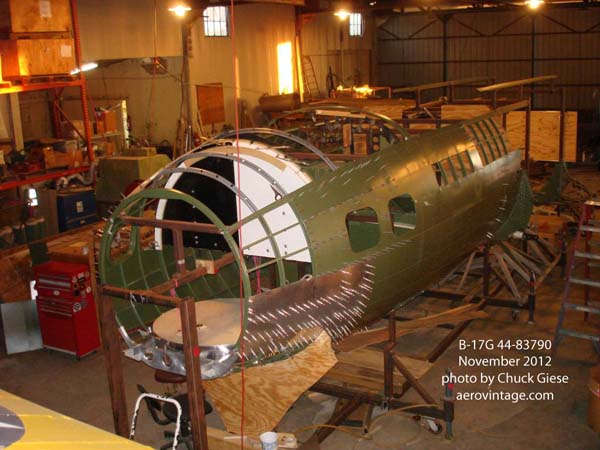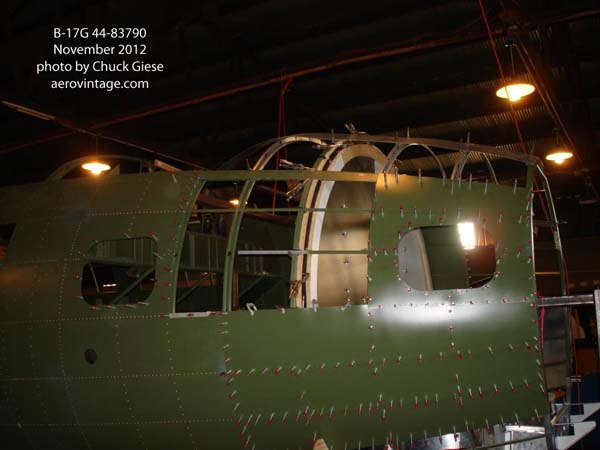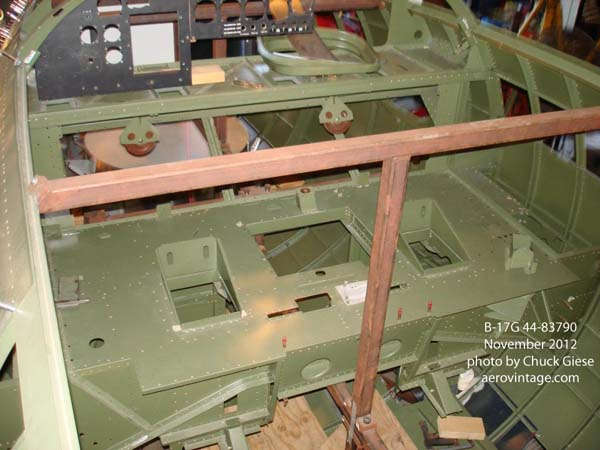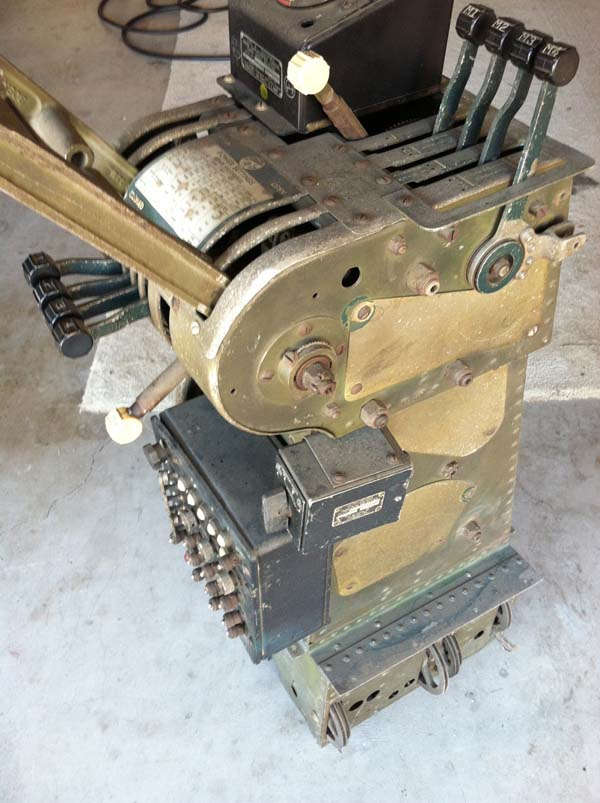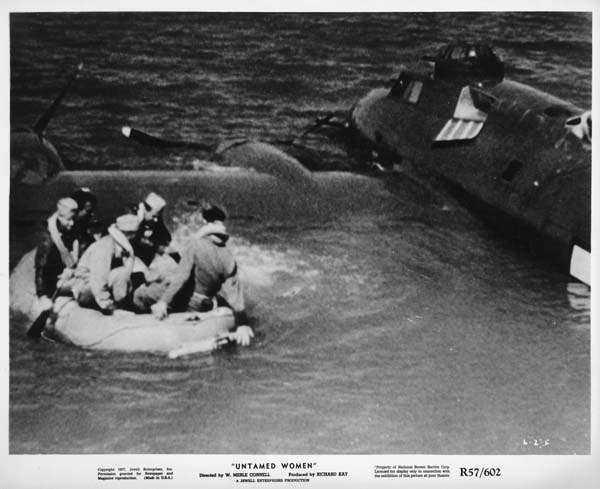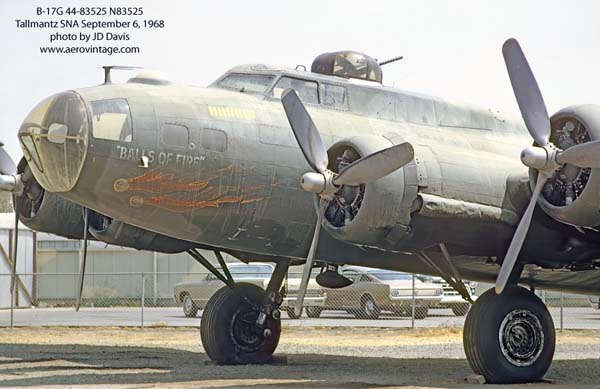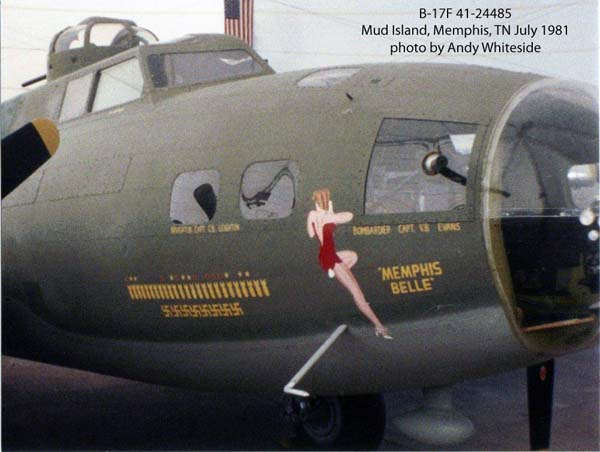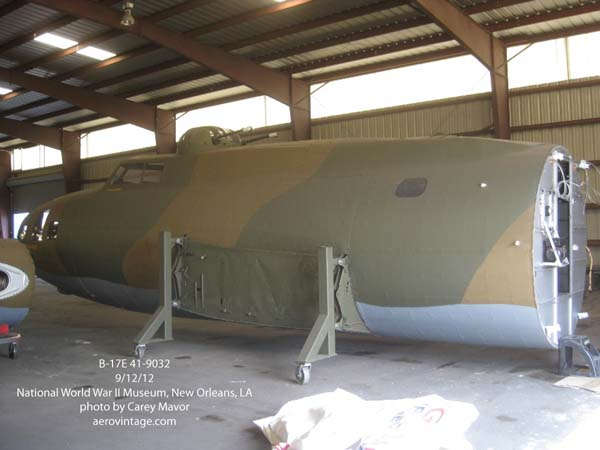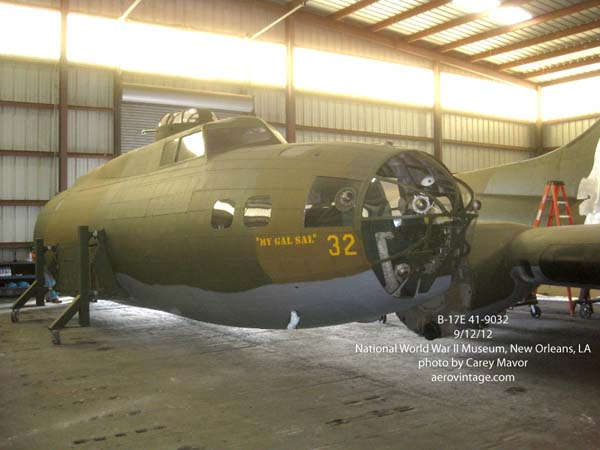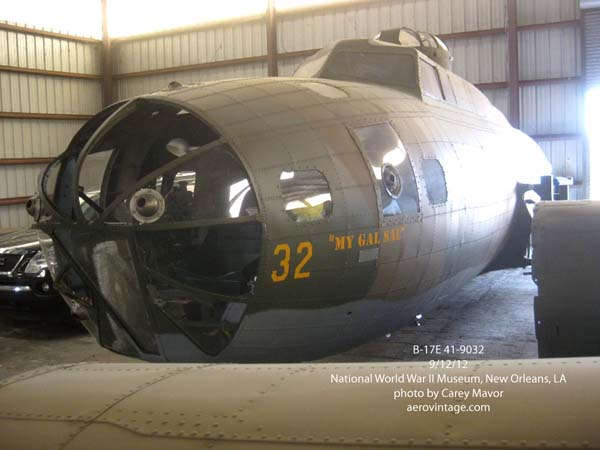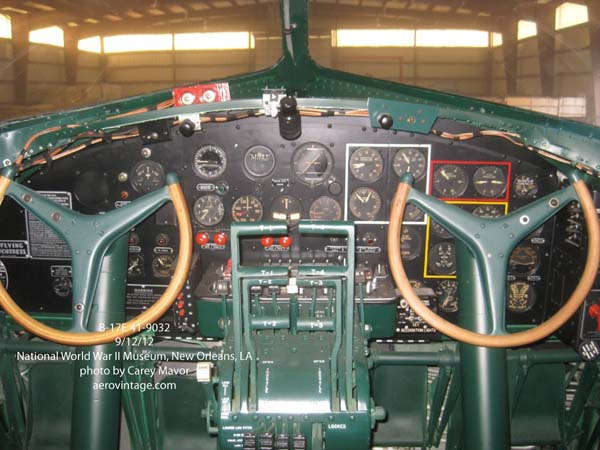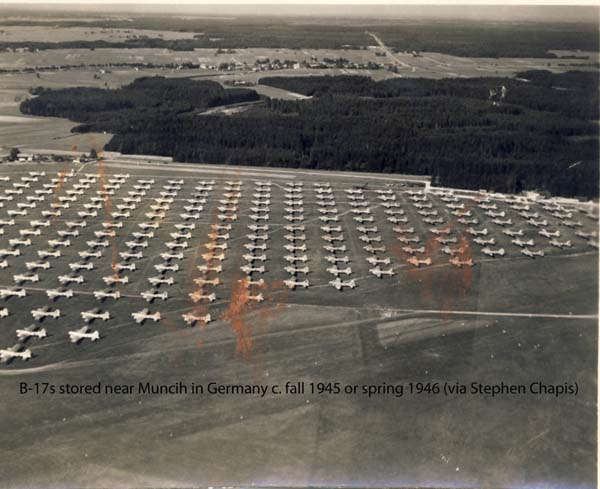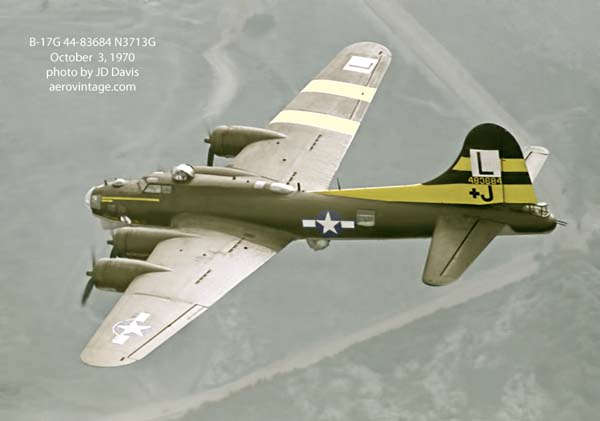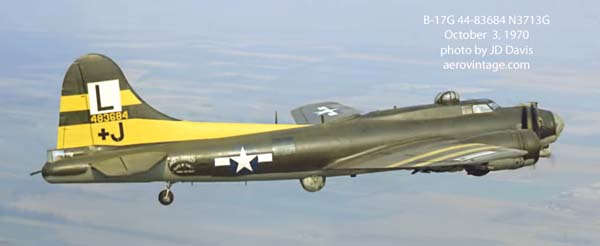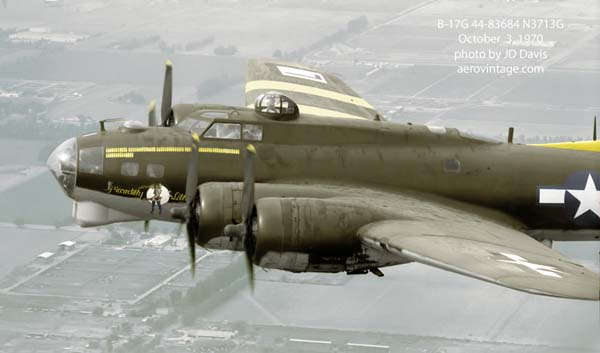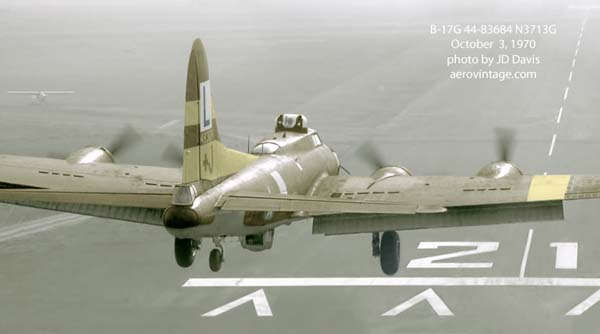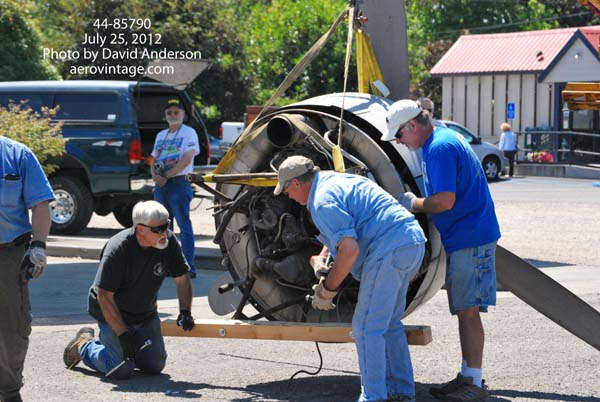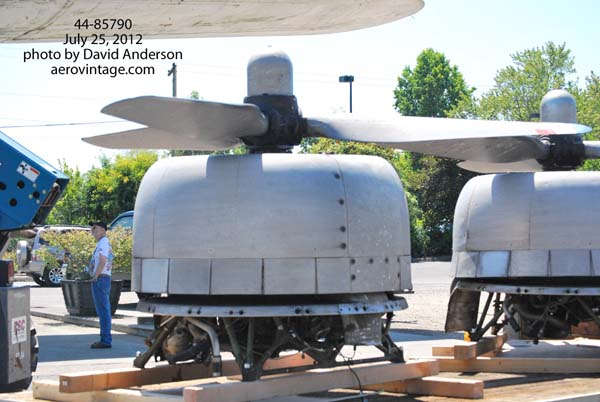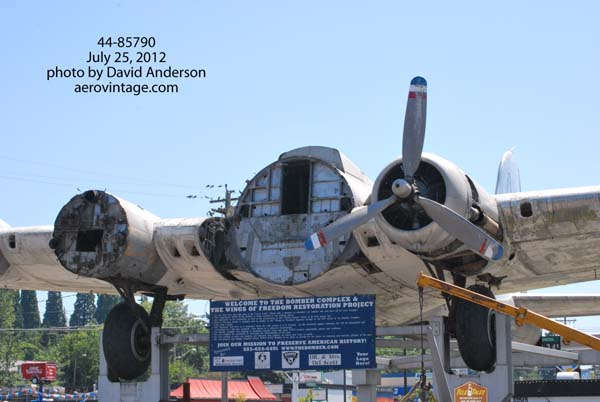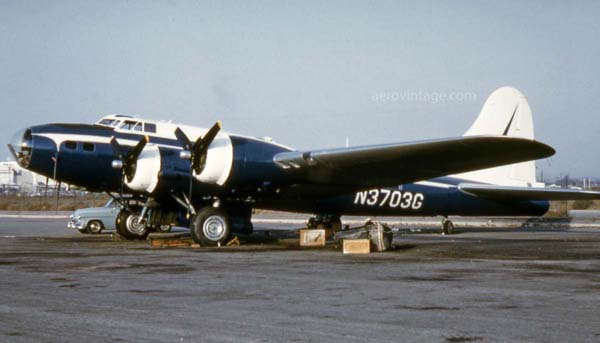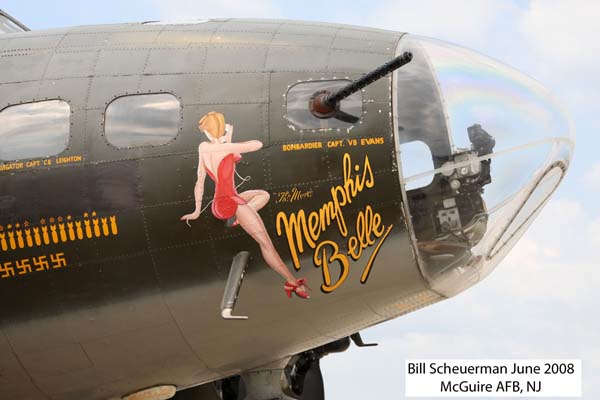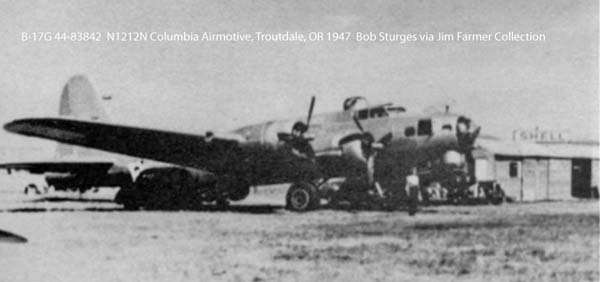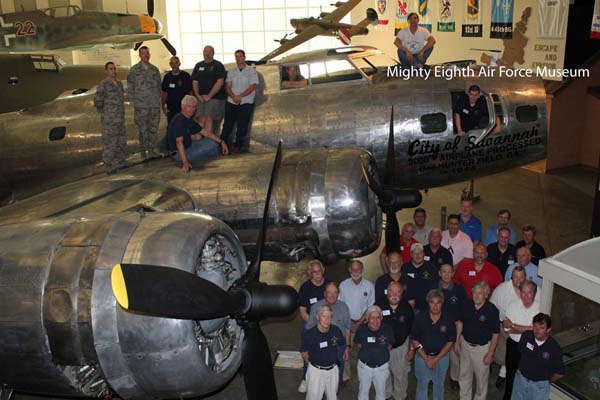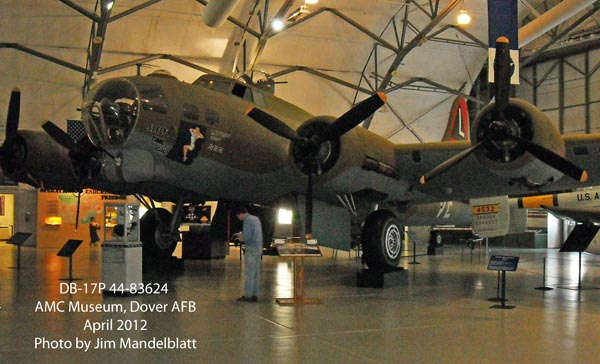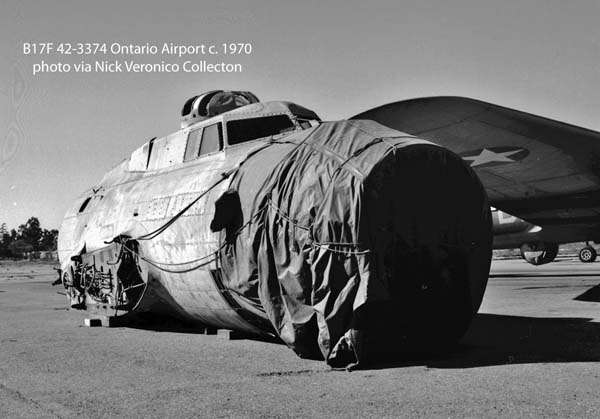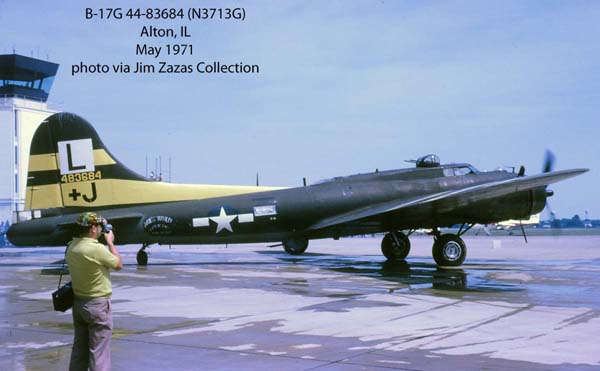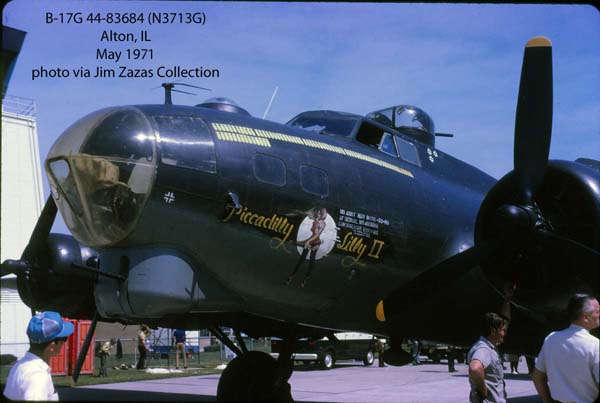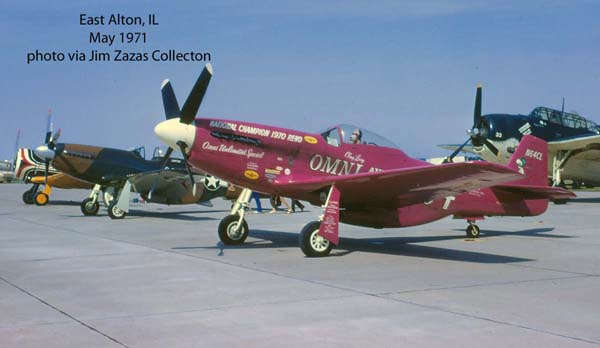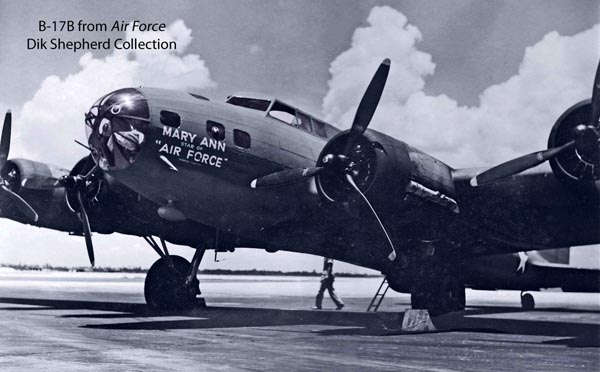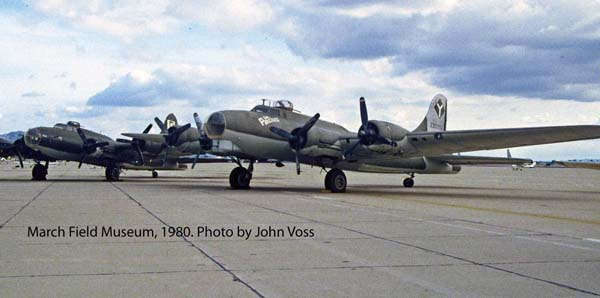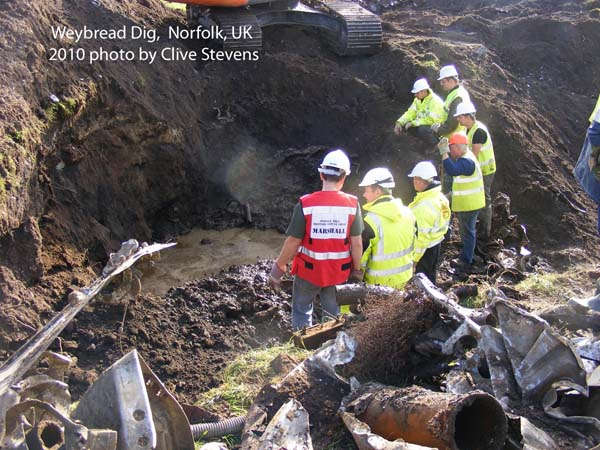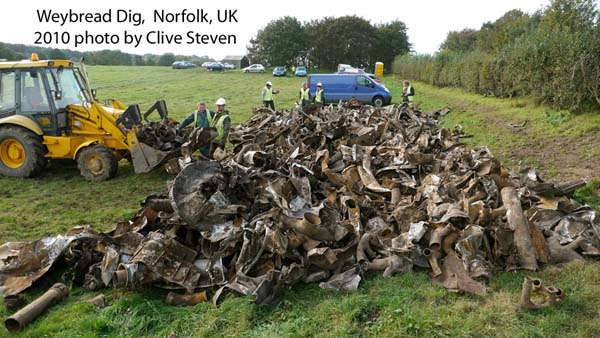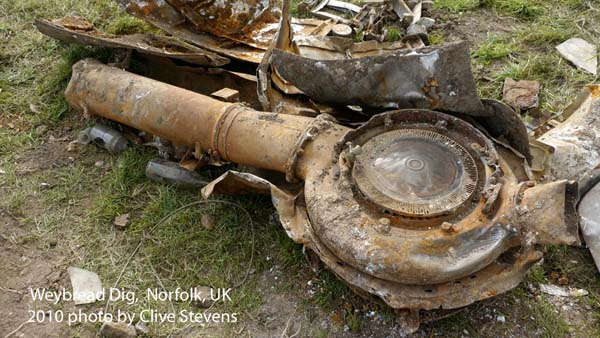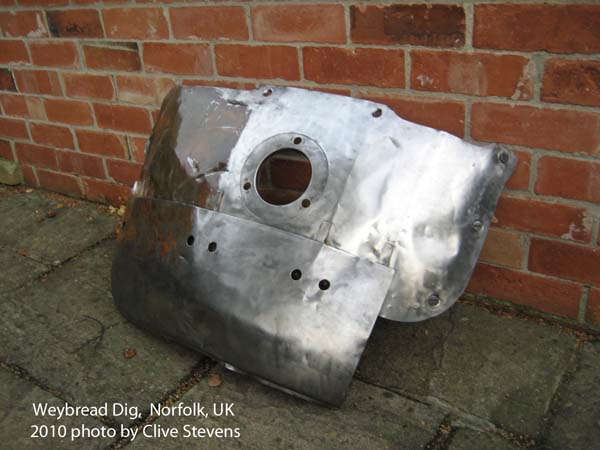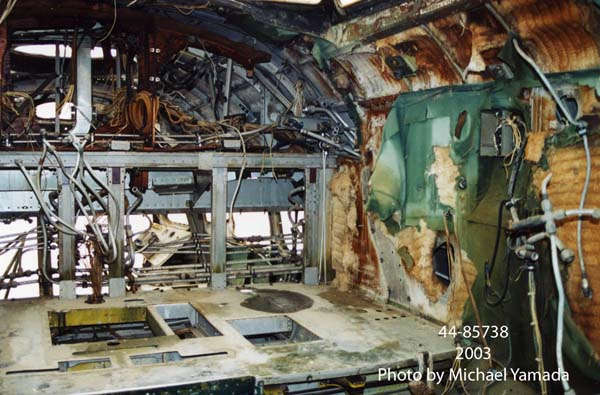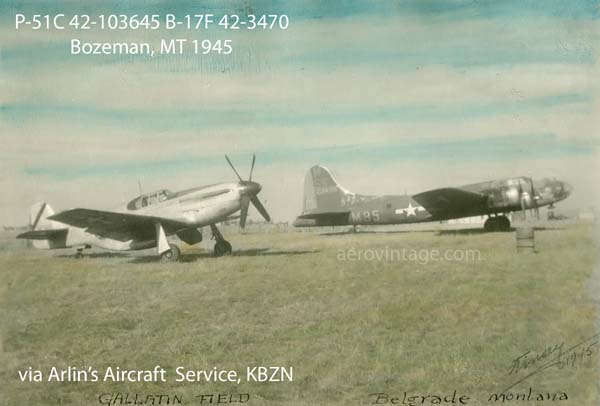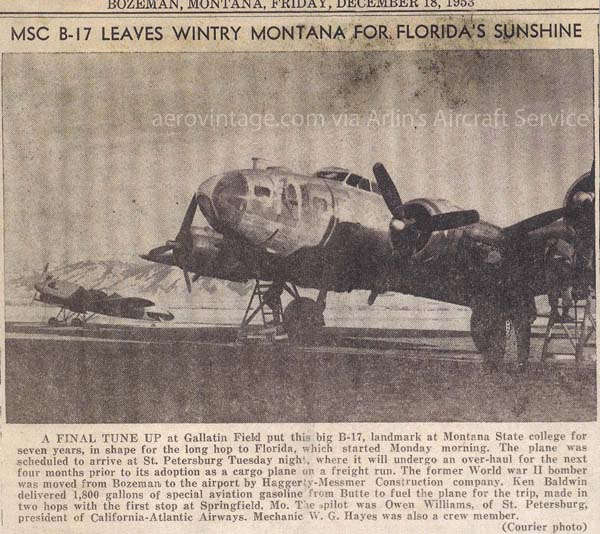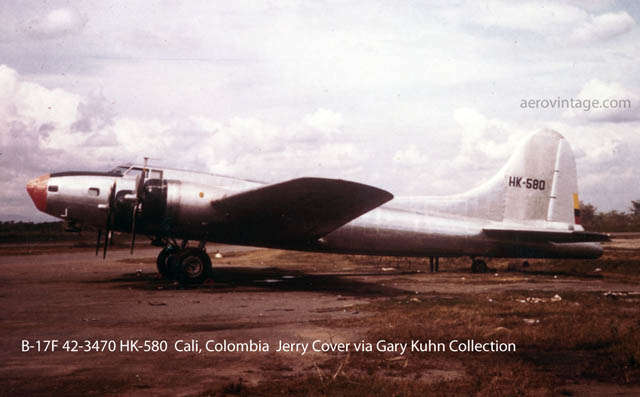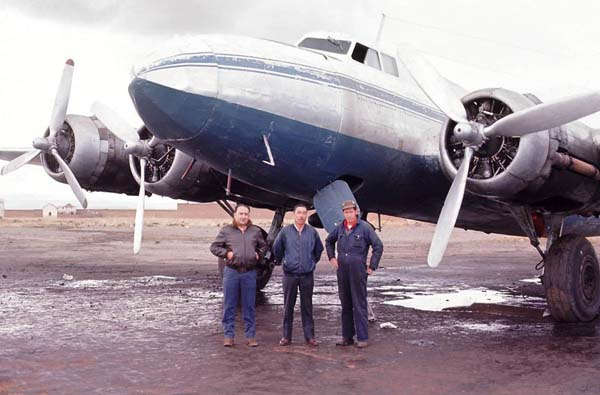
| site search by freefind | advanced |
AERO VINTAGE BOOKS
2012 B-17 NEWS
B-17 News Archive
2018 B-17 News
2017 B-17 News
2016 B-17 News
2015 B-17 News
2014 B-17 News
2013 B-17 News
2012 B-17 News
2011 B-17 News
2010 B-17 News
2009 B-17 News
2008 B-17 News
2007 B-17 News
2006 B-17 News
2005 B-17 News
2004 B-17 News
2003 B-17 News
2002 B-17 News
1997-2001 B-17 News
Back to the Main Page
We're including this page as an update point for B-17 news. We'll post information garnered from any variety of sources, and notate that source at the end of the item. If anyone has anything they'd like to add, please let us know.
B-17 Tour Information
- Beginning in June 2012, the Liberty Foundation began touring with the leased mock Memphis Belle, 44-83546 (N3703G). Check out the most current information here.
- The Collings Foundation B-17G Nine-O-Nine, 44-83575 (N93012), is between tours now, with the 2013 tour set to start in January in Florida. For the most current information, jump to here for schedule information.
- The Commemorative (ex-Confederate) Air Force's B-17G Texas Raiders, 44-83872 (N7227C), is flying again and offering rides and appearances. Jump to here for show dates and ride information. A 2012 schedule is posted.
- The CAF's other B-17G, Sentimental Journey, 44-83514 (N9323Z), has dates in October posted for the southwest. The Arizona Wing's page can be found here for the only Wing information posted for Sentimental Journey.
- The Experimental Aircraft Association's B-17G Aluminum Overcast, 44-85740 (N5017N), has completed its 2012 touring. Check out the most current information for the 2013 tours here.
- The Yankee Air Force out of Willow Run, Michigan, operates the magnificent B-17G, 44-85829 (N3193G), Yankee Lady. Rides are being scheduled on the airplane from the YAF base at Belleville, Michigan. Jump to here for their most current information.
- The Lone Star Flight Museum's Thunderbird, 44-85718 (N900RW), based at Galveston, Texas, offers a ride program. The museum has ride dates scheduled. Check out the most current schedule at right here.
December 2012
- Progress on 44-83790 Restoration: Chuck Giese posted some very recent photos of the impressive work underway at Douglas, Georgia, on restoring B-17G 44-83790, the Dyke Lake airframe recovered from Labrador waters back in 2004.
As can be seen, progress has been made on constructing a basically new fuselage using new material and parts from the recovered airframe. The jig came from Ray Moore, and a careful examination of the above photos shows the jig set up for the entire fuselage section back to bulkhead six, the production break between the forward and aft fuselage sections.
The team working on the reconstruction effort is part of the Liberty Foundation, the same group that operated 44-85734, better known as Liberty Belle, before it's sad loss in May 2011 after an inflight fire. As can be seen from the photos, this is an incredible effort to put another B-17 back into the air.
This interior view shows the cockpit looking forward, and gives a measure of the work involved in constructing a new fuselage. There was some talk about creating a B-17F fuselage, but a decision was taken to create a B-17G.
This is obviously a very long term project but the Liberty Foundation, led by Don Brooks, is determined to get this B-17G put together. There is an ongoing forum discussion on this airplane at the Aero Vintage Forum site that might bear reviewing.
- Throttle Quadrant Sold: A possibly related item to the above restoration is the sale by Mike Yamada of his B-17 throttle quadrant to the Liberty Foundation.
Mike is no stranger to these pages as he has long contributed information and photos. He had amassed a good collection of B-17 components but reluctantly decided to dispose and disperse what he has so diligently gathered. He is hopeful that this quadrant might make it into the ongoing restoration of 44-83790 and will someday once again provide a hand the control of 4,800 horsepower. As of this writing, Mike has had some other material offered on the Aero Vintage forum site.
- My Gal Sal Update: Word comes from the National World War II Museum in New Orleans that B-17E 41-9032 is being moved to its future display site in the main museum building. Here is a photo posted to a facebook page:
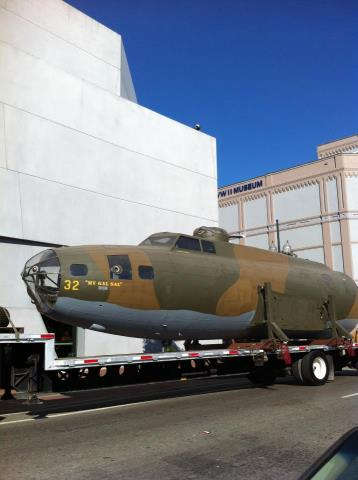
The airframe has been strengthened and lightened to allow it to be suspended fifty feet above the museum floor. Walkways will allow different perspective views of the airplane, including ones alongside the B-17E. There remains a good WIX discussion on this airplane. Jump right here to follow that a bit.
- Swamp Ghost Update: In other B-17E news, B-17E 41-2446, otherwise known as Swamp Ghost, is being prepared for trans Pacific shipment at Chino airport by Aero Trader. The B-17E, subject to several decades of controversy and dispute, is heading to the Pacific Aviation Museum at Ford Island near Honolulu.
This B-17E was the one recovered from Papua New Guinea in 2006 and has pretty much held in open storage at Chino since its arrival back in the U.S., as owner Fred Hagen tried to cement up display plans for the rare combat veteran B-17E.
Details remain sparse, but it would appear that the museum has obtained, either by purchase or donation, the airplane for permanent display. Aero Trader has gathered the various components on its ramp in preparation for what is expected to be a mid January 2013 shipment to Honolulu. After its arrival, reports suggest it will be placed on static display in a swamp setting to replicate its six decade home in Papua New Guinea. No restoration effort beyond stabilizing its condition can be expected nor is probably warranted given the condition of the airframe.
- B-17 Movie Update #1: Nick Veronico sent in some information and a photo still from an 1952 B or maybe even C movie named Untamed Women. The still is a photo of ditched B-17. A close examination shows engine number one with a feathered propeller and engine number two with a bent propeller.
Going to the trusty and invaluable IMDB entry for the film, we find the plot as follows:
During World War II, an American bomber pilot is rescued after drifting at sea aboard a raft. After being administered truth serum, he tells the doctor a story of how he and the three survivors of his plane crash washed up on an island that was inhabited by a tribe of beautiful primitive cave-women, dinosaurs and a group of savage cavemen who are bent on abducting the women for breeding purposes.
Folks, this is good stuff here and this film definitely qualifies for an entry on the Aero Vintage B-17 Movie List page. One suspects that the footage used in the film was war surplus, i.e. AAF footage maybe from a training film, but until someone finds and watches the film, we won't know for sure. Even then, maybe not. Thanks to Nick for his eagle eye and possibly questionable taste in movies.
- B-17 Movie Update #2: Patrick Whitham sent in some information about a June 1942 short film entitled Men of the Sky. To quote Patrick, since he did most of the research here:
Just wanted to pass along some information regarding a film I viewed last night on AMC, American Movie Classics. It was some type of short piece about a group of men going through flight training during World War II, and was obviously filmed at that time, in color to boot. Towards the end of the film, as the trainees graduate up the chain of aircraft, there is some excellent footage of several B-17E's. They are filmed on the ground, flying in formation, and individually. The only plane I could make a serial number for was 41-2568. I did a little research and have been able to determine that this aircraft was assigned to a training squadron at Lockbourne Army Air Field in Ohio in 1943 and 1944. It was apparently involved in two accidents while there, both classified as 'Landing Accident Caused by Mechanical Failure'. I've not found anything else beyond that, but I'm sure there is more out there. Regardless, I thought you might be interested in this film and the B-17's shown in it, and perhaps could use your resources to determine the ultimate fate of 41-2568 as well as identify the other Fortresses displayed.
Once again, a link to that invaluable and trusty IMDB entry for the film. One suspects this 20 minute film was maybe shown in movie theaters before the main features?? Downside is that there are apparently no dinosaurs in the film.
To expand on Patrick's information about B-17E 41-2568, my trusty Freeman/Osborne The B-17 Flying Fortress Story reference source tells us that this B-17E was delivered from Boeing on February 9, 1942, and apparently spent its entire utilization in CONUS training units. It ended up with the RFC for disposal at Albuquerque in July 1945 and was undoubtedly scrapped there.
Add another one to the Aero Vintage B-17 Movie List page. This stuff keeps jumping up. Cool.
- Just A Photo of Balls of Fire: JD Davis had passed along some Tallmantz photos that I have added to my Tallmantz pages, but just had to include one here of the one he sent me of a B-17 near and dear to my heart, 44-83525 at Orange County in September 1968, eight months after it had been used in the film Thousand Plane Raid.
- Boeing Plant 2 Commemorated: Kevin Kelly sent in information about a semi-memorial and plaque that Boeing has installed to commemorate the now-demolished but historically significant Plant 2 on Boeing Field in Seattle. The plant was the birthplace to almost all the Boeing built B-17s, save a few of the early production airplanes, and later saw a good part of Boeing's post war airplane production of B-52s and others roll out its doors. According to a Boeing News article, a 10-foot section of an original lattice column has been installed near the original building with a plaque installed.
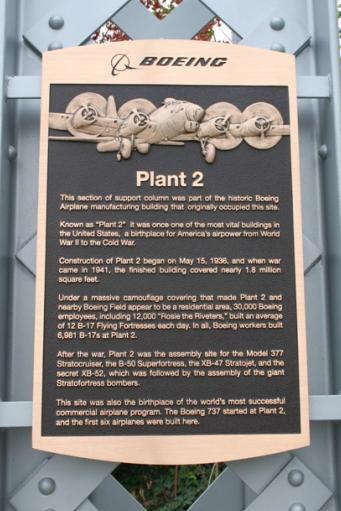
The plaque reads:
This section of support column was part of the historic Boeing Airplane manufacturing building that originally occupied this site.
Known as “Plant 2,” it was once one of the most vital buildings in the United States, a birthplace for America’s airpower from World War II to the Cold War.
Construction of Plant 2 began on May 15, 1936, and when war came in 1941, the finished building covered nearly 1.8 million square feet.
Under a massive camouflage covering that made Plant 2 and nearby Boeing Field appear to be a residential area, 30,000 Boeing employees, including 12,000 “Rosie the Riveters,” built an average of 12 B-17 Flying Fortresses each day. In all, Boeing workers built 6,981 B-17s at Plant 2.
After the war, Plant 2 was the assembly site for the Model 377 Stratocruiser, the B-50 Superfortress, the XB-47 Stratojet and the secret XB-52, which was followed by the assembly of the giant Stratofortress bombers.
This site was also the birthplace of the world’s most successful commercial airplane program. The Boeing 737 started at Plant 2, and the first six airplanes were built here.
Thanks to Kevin for sending this in and to Boeing for the information and photos and B-17s.
- Memphis Belle Circa 1991: Andy Whiteside sent in a bunch of photos he had taken of B-17F 41-24485 taken while the airplane was displayed at Mud Island in Memphis in 1991. This one is representative of the airplane's condition at the time which, at least externally, was not that bad.
The airplane was somewhat protected from the worst of the elements, but still suffered from the environment and incessant bird presence. Just about all would now concede that the future of the airplane is much better at the NMUSAF facility at Dayton.
October 2012
- My Gal Sal Update: Carey Mavor sent in some recent photos, taken in early September, of B-17E 41-9032 in short term storage at the National World War II Museum. As noted in the August update below, the airplane was acquired in a surprise move from Bob Ready and the Ultimate Sacrifice group, and quickly trucked from Ohio to the New Orleans facility. It is being prepared for hanging display in the museum.
Also of interest was this WIX posting from "runninwild" about his dealings with the museum and work toward preparing it for display, quoted here in its entirety:
I am currently working as a consultant for the National WWII Museum and can update everyone on the status of the B-17 projects. Due to the time schedule for the display, airframe 44-83387 is not coming here. There was just too much work to complete for the short schedule. "My Gal Sal", 41-9032, is here and will be displayed in the Freedom Pavilion: The Boeing Center scheduled for opening on January 11, 2013. I am currently working on strengthening of the lift points as it is our intention to display "The Gal" in a combat configuration. She will be suspended in the air inside the pavilion, fully armed and crewed, with the bomb bay open dropping a stick of bombs. She never got a chance to fight, but it is our intention to show what she could do. There are some rather extensive mods necessary, particularly to the bulkhead 7, where she will be suspended from. Mr. Ready and his people did a remarkable job, but it was never their intention to hang the aircraft. For safety reasons, I am replacing bulkhead 7 and strengthening the entire area. Remember, people will be walking underneath the aircraft while it is on display. After the structural mods are complete we will mock up and fit check the entire airframe, then disassemble it for transportation to the Museum. At present, the aircraft is in a warehouse for the mods. 4 other aircraft are scheduled for display with The Gal, a B25J that has been converted to a PBJ configuration, a F4U-4 Corsair, a TBM Avenger, and an SBD Dauntless. I can't tell you how much fun it is working on these aircraft. I even got to meet a Corsair pilot last month. He was 90 years old, but he acted like he was 19 when he saw our Corsair. He was soooooo cool!]
So, work is moving forward quickly to get this airplane on display. It is not a simple task to suspend a B-17 safely; empty weight was more than 32,000 pounds for a standard equipped B-17E, and I would think My Gal Sal comes close to this.
- Yankee Air Force Yankee Gala---Celebrating the B-17 Flying Fortress' Contribution to History: A reminder that seats are going fast for the B-17 Gala being held by the Yankee Air Force on November 10, 2012, at Bellville, Michigan. Check out this site for more information and ticket purchases.
- B-17G City of Savannah Restoration Effort Dedicates New Website: The team restoring the B-17G 44-83814 at the Mighty 8th Air Force Museum now has a dedicated website towards that effort. Check it out!
- Swamp Ghost Rumbles: Some information has surfaced that suggests plans that B-17E 41-2446, better known these days as Swamp Ghost is, indeed, heading for the Pacific Air Museum for display, probably sometime next year. Details when available.
- German Airfield Identified: Way back in the May 2012 update we asked a question about where this B-17 depot storage airfield was in the early post-war period in Germany.
Well, we have an answer, sent in by Freidrich Braun of Ulm, Germany. He writes (edited just a bit by the webmaster):
Just want let you know the location you asked is Holzkirchen near Fürstenfeldbruck, a little west of Munich. Fürstenfeldbruck was a German Airfield with runway and was used by the AAF right after the war for Fighter Wings, Army Air Force Reinforcement Depot, Overseas Deployment Base for SAC (B-29's)and the first US Fighter Jets was based there in the 50's.
He is kind enough to note the source: Airfields of the Luftwaffe (ISBN 978-3-86619-054-2). Thanks to Freidrich for answering this question.
- Bathtub Guns: I received an interesting email from John Meshkoff that goes into some detail about the gun mounts used on the B-17C and B-17D "bathtub" belly guns. It is pretty detailed but should be of interest to those schooled in such things. I present it here with the photos used in the 2010 updates that he is referring to. John writes:
I’ve been making a study, over the past year or so, of the B-17 flexible (manual) .50 caliber gunnery, and on Friday morning had a telephone-talk with Paul Silberman, Museum Specialist (History) at NASM Archives in order to get drawing descriptions for the special .50 caliber ammo boxes used on the early B-17’s (I had previously written a request for box and flexible-adapter info on the B-17D, and had received the response and document copy order forms a couple days ago). I’ve been following the Swoose restoration ever since I first contacted NMUSAF while trying to find an ID on the relatively familiar side-gun box seen in many early B-17 E & F photos (they had no info on the side-gun ammo-box, yet they are restoring two aircraft that were originally equipped with that box, “The Swoose” and “The Memphis Belle!”; I’m sending them NASM’s info).
BTW, that is the reason that the bulk-feed “restoration” was removed from the Memphis Belle; IIRC it was retired from combat in the first half of 1943, and to the best of knowledge to date bulk-feed was first introduced sometime in the second-half of that year (an Air Force photo from National Archives dated July 22, 1943 shows the side-gun box still in use, and a photo in the book “Warrior – A Visual History” by R.G. Grant shows a photo of B-17 waist-gunners identified only as “in England, 1943,” and shows an E or early F with the original side-gun boxes in their racks, but the guns have been up-graded to bulk-feed with the bulk-chests slung overhead, and the flex-tubes festooning down to the guns).
Paul described the drawings for what turns out to actually be two different dorsal gun boxes, and I’m about to put in a copy order for the Boeing drawings of the 3 boxes; Boeing designed the boxes, hence they do not show up in any of the Army T.O. parts catalogs as they came with the aircraft from the factory. NASM thought the box p/n’s were for one side-gun, one dorsal, and one ventral box; in fact they are two dorsal and one side-gun box.
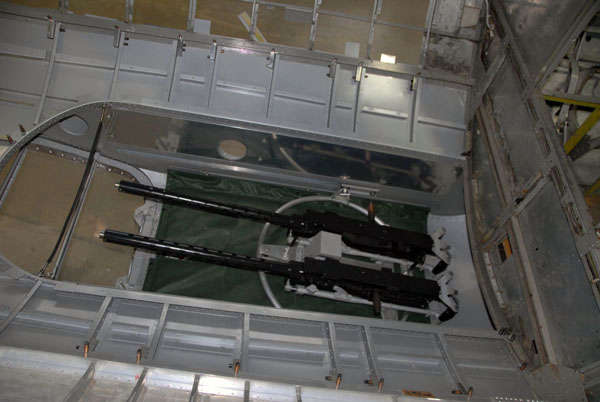
One of the photos on your B-17 News Archive (2010) article on the “Swoose” bathtub restoration shows what is in fact an original B-17D dorsal-gun photo, though it has been mis-associated with an original photo of a B-17C bathtub exterior. Same with the “Swoose” bathtub; the photo accompanying it is actually the dorsal-gun restoration, look at the NMUSAF article on the B-17D and look through the 18 photos (IIRC, that same photo is the last and most recent photo in that group).
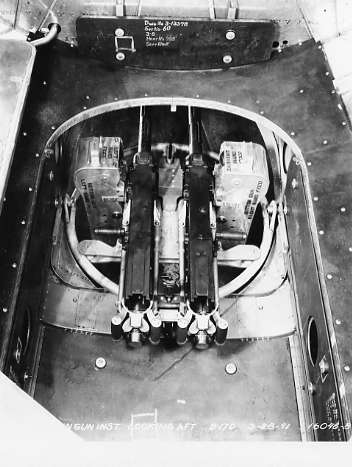
The adapter in both those dorsal photos is a dual E-5 (E-series are all .50 caliber adapters, and IIRC the Navy calls the E-5 series Mark 6), and the deep, rectangular ammo boxes seen in that original B-17D photo are Boeing P/N 15-6999. The older curved boxes on the dorsal-mount seen in the 1943 release “Air Force” are P/N 15-7453, and those boxes appear to actually make up that ring-mount when combined with a pair of E-8 adapters and the necessary hardware (the E-8 is the adapter seen in all those early B-17E & F side-gun photos, and also seen on all the guns in “Air Force” although both the E-8’s and M2’s used on screen are actually prop-replicas). E-8 listings first appear in the B-17E parts catalog, though they may have been used on the C & D and supplied by Boeing rather than being brought aboard by the Army since no gun-mount adapters appear in the combined C/D parts-catalog.
The two dorsal-boxes are not interchangeable; the older box rides parallel on the ring with the guns perpendicular to the ring, and the newer boxes are attached to the E-5 mount and as seen in the old photo are perpendicular to the ring with the guns parallel to same. The older mount has a more complex suspension from the overhead rail, the dual E-5 version has very simple toggle-plates as seen in the restoration photo.
BTW, the Army Parts Catalog and Flight Manual T.O.’s for these early B-17’s are not wholly reliable; there are definitely errors in regard to gunnery details and drawing p/n’s (according to NASM’s experience). The old photos with the dates written on the negatives are therefore invaluable.
- October 1970 Views of Picadilly Lilly II: JD Davis saw the photos posted on B-17G 44-83684 visiting an airshow in Illinois back in 1971 and pulled these photos of his collection. They show some views of the B-17G when it was being flown from Ontario to Chino back on October 3, 1970. Cool, cool, photos. As I told him, I wish I had these for the 4th edition of Final Cut; they would have fit in very nicely.
As has been reported here, this airplane is undergoing a gradual restoration at the Planes of Fame facility at Chino. However, money is lacking and I had a chance to take a close look at the airplane recently. A definite challenge is facing the restoration team and without a good funding source, I suspect it is three steps forward and two steps back on a regular basis. Money money money.
August 2012 Update #1 8/3/12
- My Gal Sal To New Orleans' National World War II Museum: In an surprise move, B-17E 41-9032, otherwise and better known as My Gal Sal has been donated by owner Bob Ready and the Ultimate Sacrifice group to the National World War II Museum at New Orleans, Louisiana. The airplane is being moved in early August, like right now, out of its long term storage warehouse at the Blue Ash Airport near Cincinnati, Ohio, shrink wrapped, and will be trucked to its new home. Surprising move because another B-17, B-17G 44-83387, had been under static restoration by a California group and slated for the New Orleans museum. Those plans have been shelved, and the B-17E will now be the one going on static display.
My Gal Sal is a B-17E that was bellied onto the Greenland ice in June 1942 while being ferried to England in the early days of the 8th Air Force buildup. The crew rescued, it was forgotten until 1964 when it was rediscovered and surveyed. It largely remained undisturbed by all but viscous Arctic storms until it was recovered from its remote location in 1995 by 'Air Pirate' Gary Larkins. It was eventually obtained by Bob Ready, an 'outside the box' thinker who was dedicated to getting the airplane on display at a facility at the Blue Ash Airport as a tribute to World War II airmen. The airplane was a pile of wreckage when obtained by Ready, but with the help of Larkins and his team at Auburn, California, and a good group of volunteers in Ohio, the airframe came back together in an amazing static restoration. Ready's plans for Blue Ash display facility was continually frustrated by local politics. Those local politics have now led to the ultimate closing of the Blue Ash Airport and, presumably, this led Mr. Ready to seek a display location elsewhere. The airplane has been tucked away in a storage facility for the last decade, held in disassembled storage for the day it took its place on display, a day that did not come in Ohio.
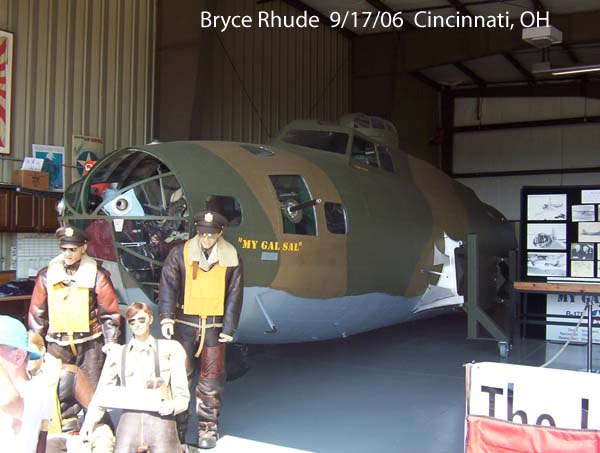
There is no information yet about the acquisition of the B-17E on the museum website as of August 3, but it is also presumed that when the B-17E shows up, it will be reassembled and eventually hung from one of the museum's display buildings that was built for just such a thing. Surprising news; a bit sad for Bob Ready and his ambitious plans for the airplane, but it will put another B-17 on static display.
And what of B-17G 44-83387? This airplane is being pulled together from the parts of several, with the majority of the forward fuselage coming from a bar display at Greeley, Colorado. This airframe, when there were more parts to it, was the fuselage set used in the 1948 production of the film 12 O'Clock High and used again in the earl 1960s TV series of the same name. Bruce Orriss obtained it in 2007 and the museum deal was set in 2010. Work was underway by Larkins at Auburn and another group in Los Angeles to pull together a complete static museum from a bunch of different components. Inner wing panels proved to be problematic but signs were there that this obstacle would be overcome and the airplane would eventually be displayed at the New Orleans museum. Not to be, it turns out.
The future of this airframe? Not announced yet but it should be interesting and it may be heading in a new direction. I wait in anticipation of yet another twist in the world of B-17s.
It's hard to keep track of this stuff, but it might be fodder for the 5th Edition of Final Cut. Perhaps you should purchase a copy of the 4th Edition while they are still available, heh heh.
Update #2 will come when some kind soul sends me photos of the shrink wrapped B-17E moving on out. Check back soon...
August 2012
- Gas Station B-17 News: Interesting and long awaited news coming out of Milwaukie, Oregon, where B-17G 44-85790 has been displayed atop a gas station complex since 1947. Correspondent David Anderson reports that:
On Wednesday, July 25, 2012, the owners, Punky Scott (Art Lacey's daughter), and Jayson and Terri Scott (Art's grandson and wife), started the next phase in the restoration process of the plane. All four engines and propellers were removed and placed on a flatbed trailer to be transported to a hangar. Their goal is to have the entire plane disassembled and moved to a hanger in Aurora, Oregon, owned by Tim Gadeler, within the next 18 months, where the restoration will take place.
For those following this airplane over the years has watched with a bit of frustration as the nose section came off the airplane and was partially restored. Much of the actual cockpit section is reportedly still outdoors at the Aurora airport so perhaps this news of a restoration beginning at that location will bring the parts indoors.
One of the engines is shown here after being pulled down from the nacelle.
According to David, all four have been removed and trucked to Aurora.
If the plans materialize, the airplane will soon enough come off its long standing perch and get some much needed love and care. This airplane came out of the surplus stocks in February 1947 and was a new airplane when Art Lacey got the airplane. See item on Altus, below, for the rest of part of the story.
Money is always the problem with efforts such as this. Take a visit to the Lacey Lady website for more information and a giving opportunity for everyone to help support this airplane project. Thanks much to David for passing along this information.
- Yankee Gala on November 10, 2012: If you live between the Mississippi River and the Atlantic Ocean, or other places, you might want to mark your calendars for the Yankee Gala to be sponsored by the Yankee Air Force on November 10. The event is dedicated to "celebrating the B-17 Flying Fortress' contribution to history.
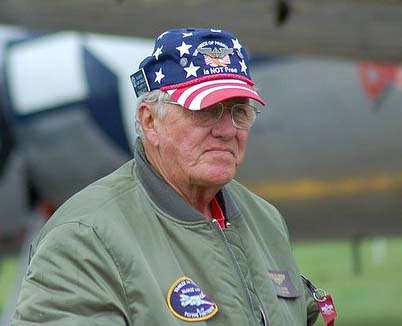
As a featured aside, long time Yankee Lady crew chief Norm Ellickson is receiving the Yankee Award of Valor for his long standing contributions towards keeping a B-17 in the air. Check out more information at the Yankee Air Force website right here.
- Lackland B-17G: Not news, but Dan Stroud sent me a couple of update photos of the B-17G displayed at Lackland AFB, Texas, where it's been parked since the mid 1950s. Not too bad looking from a distance; reportedly, very rough when examined closely.

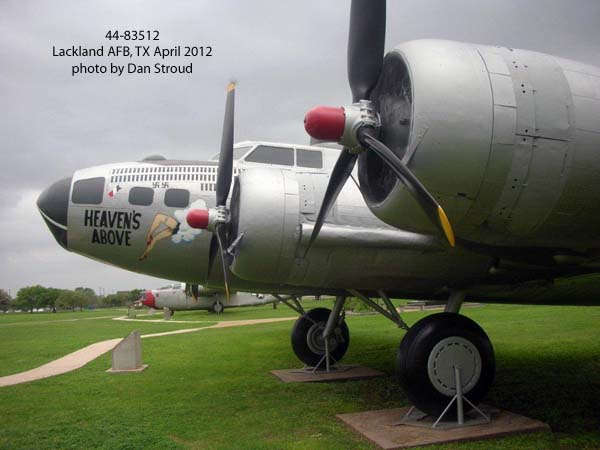
- German Post War B-17 Storage Depot Identified:Our May 2012 query about the post war German airfield full of B-17s elicited this response from Friedrich Braun of Ulm, Germany.
Just want let you know the location you asked is Holzkirchen near Fürstenfeldbruck, a little west of Munich. Fürstenfeldbruck was a German Airfield with Runway and was used by the US Air Force right after the war for Fighter Wings, Army Air Force Reinforcement Depot, Overseas Deployment Base for SAC (B-29's)and the first US Fighter Jets was based there in the 50's.
The photo in question was this one:
And that long German city that starts with the "F" above is noted on aircraft record cards as being a storage depot. Okay, then, another answer to another question. Thanks to Friedrich.
It might be noted, sadly, that most of these brand new B-17s were eventually blown apart with explosive charges and then released to local scrappers. Cheaper than flying them hope to be scrapped.
- Dominicans and Israelis and NL1212N, circa 1948: A bit more information has come into my hands in the last few weeks that has forced me to change my conclusions about two civil B-17s and their fates. First off, I have stated many times over the years how I thought that the mysterious fourth Israeli B-17 (sounds like the fifth Beatle) was 44-83842 (NL1212N), and I continued my thesis in the June 2012 update below.
My conclusion was based on circumstantial evidence and dates that closely matched. In years past, I had requested the FAA registration file on NL1212N to no avail; it was reported as lost. I recently tried again and, lo and behold, it showed up in my mail on a CD.
Well, the registration record pretty much definitively shows that this airplane was exported by owner Babb Company directly to the Dominican Republic in September 1948. If the registration record is to be accepted as correct, this would seem to eliminate the thinking that 44-83842 was the B-17G that was at Halifax, Nova Scotia, on July 12, 1948, having been seized by the Canadian authorities. That B-17 was marked as NL7712M, not a known assigned CAA registration for a B-17 and presumed to be bogus.
- Dominicans and Israelis and NL7712M, circa 1948: So, then, what of that fourth Israeli B-17G, the one photographed with the civil registration of NL7712M in 1948? A close look at the fuzzy photos available of the airplane taken either at Halifax or at Westchester, New York, or at Santa Maria in the Azores in that summer of 1948 (accounts differ) show the crudely applied NL7712M and also a crudely overpainted military serial number. I strangely never had taken a close look at what those overpainted numbers were, but they are definitely not 44-83842. Through a process of elimination of known information about possible serial numbers it could be, it is probable the overpainted serial number is 44-85764. It could also be 44-83784 or 44-83764, both of which are have missing record cards. At this point, however, it is possible it is actually 44-85764, which is the serial number ascribed by Alex Yofe in his excellent book on the Israeli B-17s. As per the record card, 44-85764 was stored at Altus after October 1945 with hundreds of other new B-17s. However, it drops off the radar screen at that point. No further record of this airplane has since surfaced in CAA/FAA files, and I have conclusive proof that it was not at Altus in December 1947 based on a serial listing of 52 B-17s still on the airport under the jurisdiction of the scrap dealer that owned the remaining B-17s. The FAA also has no record of NL7712M being assigned to a B-17, this being verified by me in person by looking at the registration index card for that number and seeing the sequence of aircraft assignments.
There is an undocumented report that, in early July 1948, Israeli agent and pilot Al Schwimmer, along with fellow pilot Leo Gardner, were able to covertly retrieve a surplus B-17 seized by the U.S. government at Tulsa, Oklahoma, and that this airplane was the one that proceeded to Westchester, New York, and then on to Halifax and Santa Maria. If so, the question is raised about where this airplane was between at least November 1947 and July 1948, because it was not at Altus. The photos suggest it was quite freshly surplus with turrets (sans guns) installed. Also, it can be deduced from the available photos that the NL on the registration number is neatly applied, but the 7712M is crudely applied, suggesting the possibility that another civil registration number had been applied earlier.
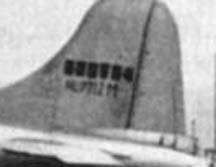
Another account (Yofe) suggests this airplane was purchased as surplus in Akron, Ohio, by Scwhimmer and Shifty Schindler. This account seems a bit doubtful since it was last recorded as being at Altus but it was not there after November 1947.
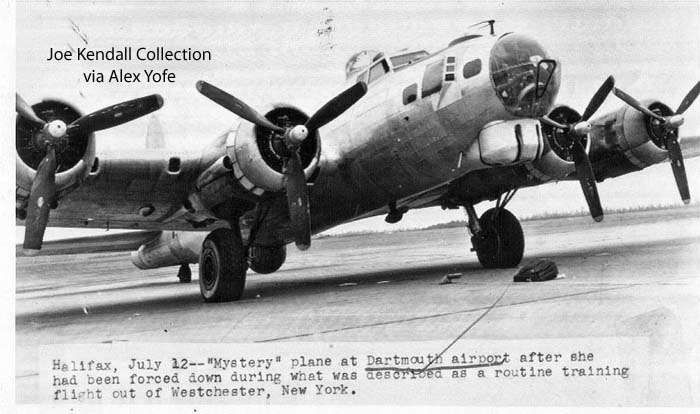
Here is a photo of the airplane at Halifax, Nova Scotia, on July 12, 1948. No help on identifying the airplane here, but notable is that is a stock B-17 with turrets installed. Also, the turbocharger ducting covers are in place. The airplane departed Halifax on July 17 and landed at Santa Maria in the Azores, where it was impounded by the Portuguese authorities.
Once seized by the Portuguese, what became of this airplane? Probably as noted below, the account of the airplane being damaged during the ferry flight from Santa Maria to Lajes Air Base is probably accurate. It was subsequently scrapped and parts used to support the five Portuguese Air Force SB-17Gs.
- Interest in Altus: With all these comings and goings involving Altus, Oklahoma, it might be interesting to review the background of that airfield and surplus B-17s. Initially, the AAF had thought to use Altus as a airplane storage facility but in mid-1945 the field was turned over the RFC to store airplanes slated for disposal. In the fall of 1945 it and a good number of other airfields began receiving the flood of surplus warplanes for disposal. Hundreds of B-17s ended up at Altus, including a good number of combat veterans including Memphis Belle and Eager Beaver. The AAF had also stored a bunch of brand new B-17s, fresh from the production lines, at Syracuse, New York. In October 1945, the AAF decided it had no further use for these airplanes at Syracuse, having a couple of hundred other new B-17s in storage at Lubbock, Texas, as well as a few other airfields. The Syracuse airplanes were moved to Altus and transferred to the RFC.
From this batch of new B-17s came most of the initial post war airplanes that joined the civil fleet. Prior to May 1947 the RFC and, later, the WAA sold two individual B-17s to civil owners at the asking price of $13,750, one in June 1946 and one in February 1947. The airplane that Art Lacey obtained in February 1947 came for this airfield also. The Navy obtained six of the surplus new B-17s in May 1947 and flew them to NAS Corpus Christi where they were disassembled for parts to support Navy PB-1Ws.
By May 1947, most or all of the older, war weary B-17s initially stored in October 1945 were apparently gone. Where did they go? Good question. I have not found any record of any large lot sized sale of B-17s from Altus prior to May 1947 similar to what occurred at Kingman, Walnut Ridge, and three other airfields in June 1946. Is it possible that 500 B-17s were moved by the RFC to another field for sale? Possible, but not very likely, given the condition of these weary airplanes after the AAF was done with them. More research is warranted here; stand by but patiently for more to follow here.
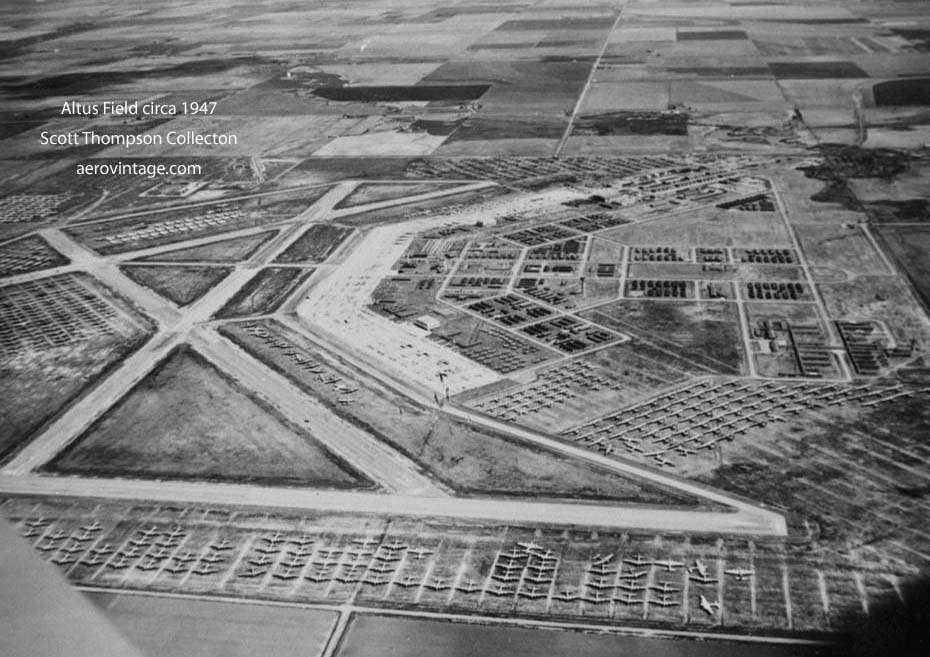
In May 1947, a lot of 423 surplus warplanes, including 73 B-17s, was offered as a scrap sale to the highest bidder. At the same time, five individual B-17s were also offered as flying airplanes. Why five and why those five? Lost to history, sadly. But, those five airplanes were sold for prices between $750 and $1,500, and all were registered as civil airplanes. The lot of 423 airplanes, along with its 73 B-17s, was sold to the Esperado Mining Company, an affiliate of the Texas Railway Equipment Corp. and the larger Brown brothers family of companies which pretty much dominated the business of scrapping warplanes in the post war period.
After that sale, if you wanted a B-17 you had to do a bit of negotiating since the Esperado airplanes had been sold for scrap only. When Pratt & Whitney wanted two B-17s for engine test programs in November 1947, it had to pay Esperado to buy the planes and the federal government a modest sum to get title to fly them. When the French government was looking for four B-17s for the IGN in December 1947, they came to Altus and worked out an agreement between Esperado and the U.S. government. And, two more B-17s came from Esperado, one in 1948 and one, surprisingly, in 1950, to join the U.S. civil fleet. Also, in December 1947, the U.S. Navy was negotiating to buy 50 of the remaining 52 Altus B-17s, again to support its PB-1W program, a deal that was never consummated but one that resulted in a detailed inventory done on November 24-25 of the remaining B-17s at Altus.
So, the airfield at Altus was released by the WAA to the city of Altus in 1948, but there were still Esperado B-17s apparently on the field until 1950. Altus was reactivated as an Air Force Base in 1953 and it remains active.
Between 1950 and 1956, when surplus Navy PB-1Ws became available, the only source of B-17s for purchase were the eleven new Altus B-17s that had been purchased between 1946 and 1950 (and three of those had been exported to Israel, one had been scrapped, and one was modified as an engine test bed leaving, actually, only six possible candidates) or the war-weary memorial airplanes scattered about the country, most far gone derelict. And that is what Altus is about. I should write a book.
June 2012
- Mock Memphis Belle On Tour: As noted last month, the Liberty Foundation has proceeded with putting the leased MARC B-17G, 44-83546 (N3703G) on a summer tour. A revamped website with tour dates and other information can be found right here. All four weekends in June have dates scheduled for areas in Georgia, Tennessee, and Ohio, starting at Peachtree-DeKalb Airport (Atlanta area) for June 9-10. The site promises that more dates will be added soon.
As a quick snapshot, 44-83546 operated primarily as a VB-17G VIP transport in its USAF years between 1945 and 1959, then was sold as military surplus. Its productive civil usage was as an air tanker with FastWays at Long Beach (CA) and, after 1967, TBM, Inc. at Sequoia Field near Visalia, California.
It was retired and sold circa 1980 to David Tallichet's Military Aircraft Restoration Corp (MARC) and primarily based at Chino for a decade or more, but also at March AFB and later, points on the east coast. It was diligently and accurately modified back to much resemble a B-17F, primarily at the urging of one B-17F devotee who shall remain nameless (Tom Wilson), down to the removal of the chin turret skin patch and installation of an early Sperry top turret, origins obscure but interesting. It's B-17F appearance lent itself greatly to its use in the filming of the 1989 movie Memphis Belle, one of five B-17s utilized in the UK for the filming. It regained an accurate marking and scheme of the real Memphis Belle for a few years, but now wears a more distinctive scheme and the disclaimer attached to its name of the movie Memphis Belle on its nose.
In recent years it has been based at Geneseo, New York, and is now being leased by the Liberty Foundation to see if everyone can win at this arrangement. Reportedly, that rare Sperry top turret has been removed from the B-17 to make room for riders, replaced, at least for the time being, with a non-distinctive skin patch.
- FAA Exemption Program Under Review: In a related note, the basic program that the FAA has put in place to allow warbird operators to offer these B-17 (and other aircraft type) flight experiences is under a revision process by the FAA that is a possible threat to future operations. Public comments are welcomed and the FAA will hold a series of public meetings in Washington, D.C. on June 26, 27, and 28. Read more about this process and the issues involved, and make a comment before June 18, right here.
Editorial comment: The Living History Flight Experience (LHFE) program is a process to operate non-standard aircraft built without any civil certification background to carry paying passengers outside of the established Federal Aviation Regulations, particularly FAR Part 91. Operators of these ex-military aircraft have been seeking to expand the exemption program far beyond the original intent of the program to include very high performance jet fighters and offer hands-on simulated air-to-air combat "experiences." Though there are those amongst us that absolutely insist the FAA has only the intent to ground all warbirds and anybody else they don't like, a more measured viewpoint might be that the FAA is entirely within its authority and responsibility to take a close look at what the point of the LHFE program is and where it should go. There are reasons that experimental, restricted, and limited category aircraft are not allowed to carry paying passengers, and there are reasons why the FAA, at the request of operators, allowed an exemption to the regulations. I would venture a guess that if this program remained limited to B-17s and B-24s this issue would not have come up. F-4 Phantoms, L-39 dogfights, and a slew of other applications for exemptions are pressing the boundaries of why the program was established and the FAA is taking a second look. In any event, make your opinion known.
- Israeli Air Force B-17s Item 1: It came out two years ago, but I finally got my hands on an outstanding book about the B-17 in Israeli Air Force service. Authored by Alex Yofe and entitled, not surprisingly, B-17G Flying Fortress in Israeli Air Force Service 1948-1957, it is published by White Crow Publications and is the third in a series by Yofe on the Israel Air Force.
I have reviewed the book on my review page, so you can jump there for some specific salient points, but in a nutshell, the book is 96 pages and jam packed with a hundred or more photos of the three B-17s that made up the strategic bombing force for Israel between 1948 and 1957. Good stuff here. Most very learned B-17 guys figured there were about five photos of these B-17s in service, and they have been often seen. The author, born and raised in Israel with some connections of his own, sifted out these hundred more photos and interviewed many of those with direct knowledge (they were there) of these B-17s in service.
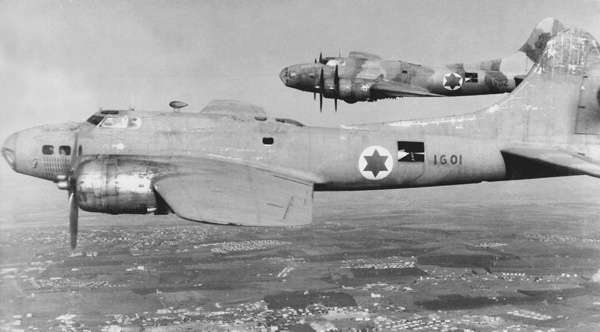
I had the opportunity to sit through a program held by the Society for Aviation History, a fine Bay Area historical group, at the old NAS Moffett Field recently, and it featured Alex Yofe doing a presentation on the creation of the Israeli Air Force and its participation in the 1948 War of Independence. The B-17s played a major role in this war and how they got to Israel in itself is a story full of intrigue and mystery, drama and surprise. That story is not fully told in this volume, but enough of it is there to whet the appetite. This book is highly recommended for anyone with any interest in the post World War II B-17, and it filled in some very obscure areas of question that have remained open in my research. Of course, it also raised some additional questions. I have culled out some things that I have been working on for some time and hit the high points below.
- Israeli Air Force B-17s Item 2: As a quick summary, there were four B-17s purchased on the open civil market in the United States in June and July 1948 for what was widely expected to be a bitter war between the Israelis and the Arabs to determine if Israel could exist. These four B-17s were 44-83753 (NL5024N), 44-83811 (NL5014N), mystery B-17G NL7712M, and 44-83851 (NL1098M). They were purchased by a covert group of Zionists organized by a gentleman named Al Schwimmer, who not only purchased the B-17s but just about any other capable flying machine he could get his hands on in the U.S. This included four A-20s, some C-46s and C-47s, and some Constellations. He was also in the market for P-51s or any other fighter types he could find. Plus, he needed flight crews and mechanics and spare parts and armament. There was an arms embargo in effect and the U.S. was not going to allow the export of these warplanes and supporting material to Israel, so they had to be smuggled out of the country. Some made it; some didn't.
There were similar efforts being made around the world on behalf of the Israeli nationalists, and a rag tag bunch of Spitfires, Me-109s, a few Mosquitos and other types, were all covertly purchased or otherwise obtained and smuggled about.
Three of the B-17s covertly left the USA on June 11 (two B-17s) and June 12 (one B-17) bound for San Juan, Puerto Rico. From there, it was to Santa Maria in the Azores, then on to Ajaccio on Corsica. From Corsica, it was non-stop to Zatec, Czechoslovakia, a strange destination during the Iron Curtain days, with two B-17s arriving on June 14. The Czechs were happily selling weapons to the Israelis, primarily old Me-109s, and accepted the B-17s and help prepare them for war. It was a sensitive time, for the B-17s arrived during a mandated U.N. truce, so a delivery right to Israel was avoided. They were in Zatec for over three weeks. When the truce ended on July 9, the three B-17s were delivered to Israel via a bombing mission over Cairo along the way. The arrival and bombing raid of the B-17s shook the Egyptians to the point that the tone of the war quickly changed.
The story of the fourth B-17 is told further down this page; the end result was its impoundment by Portugal.
The three B-17s that did make it played a pivotal role in the 1948 war. After the war, the three B-17s were re-equipped with the standard three power turrets and operated as the Israel bomber fleet through the 1950s. They participated in a limited way in the 1956 war and then were retired. Aside from one more operational mission as outlined below, they were set aside and placed into storage at a BEDEK (predecessor company of Israeli Aerospace Industries started by Schwimmer) lot and broken up for scrap around 1960. Only one partial airframe made it out, that being the fuselage of 44-83811 acquired as a studio set for the filming of The War Lover in 1961.
- Israeli Air Force B-17s Item 3: One of the items that Alex Yofe's book cleared up quite nicely was the story behind the assignment of N9814F to one of the Israeli B-17Gs, 44-83811 (ex NL5014N), in 1959. From the civil registration file, it would appear that this B-17 was simply sold as surplus to one Bernie B. Azarow of New York City on February 7, 1959, and was going to be ferried back to the U.S. Up to this point, my information was that the airplane had suffered a mechanical problem and diverted to Algeria, and subsequently was returned to Israel. Turns out, as per Alex's book, that what was really going on was that Israel was covertly trying to repay a favor to Cuba's deposed dictator Fulgencio Batista by shipping some weapons and supplies to him, who had by then fled to the Dominican Republic. Why Batista needed weapons at that point is a bit of a mystery; possibly he had thoughts of trying to regain the power he lost in January 1959 when Castro and his army forced him out. In any event, the the B-17 "sale" was the vehicle used, with newspaper accounts at the time reporting the B-17 was enroute to a "South American" country. When the B-17 ended up diverting into Bo'ne, Algeria with a cargo of weapons in late February 1959, the French rightly assumed that this bomber was destined for Algerian rebels then fighting a war against the French. The French seized the airplane and jailed the two man crew. Intense calming efforts by Israel succeeding in defusing an international incident and the French quietly allowed the airplane to be returned to Algeria on March 6, sans its cargo of weapons. The B-17 ended up back at Lod and was soon enough dismantled at the BEDEK storage yard.
Presumably, if the airplane had made a successful flight, it would have ended back in the U.S. after all and might still be around. On the other hand, it probably is just as well it didn't make it as for those on the receiving end of what those weapons might have been used for.
Now, then, as aside, a brief mention should be made of B-17F 42-3470 which, in early 1958, was assigned the civil registration of N9815F while owned by Marshall Landy and possibly involved in some low visibility, possibly covert, stuff with Nicaragua. The fact that these two civil registration numbers are sequential raises eyebrows just a bit; probably no connection but it is a bit odd with two airplanes possibly involving funny business in the same part of the world at the same time.
- Israeli Air Force B-17s Item 4: Don't read this....corrected in the August 2012 update.... So, let's think a bit about that last B-17G that ended up impounded in Portugal in July 1948. I've discussed this airplane at some length in other posting in past months and years. Here is what we are pretty sure of: This B-17G, 44-83842 was purchased as a surplus airplane by Bob Sturges of Columbia Airmotive out of Altus Field, Oklahoma, sometime in 1947. It was moved to Troutdale, Oregon, and assigned the civil registration of NL1212N. Here is a view of the airplane at Troutdale in the summer of 1947.
It was sold to the Charles Babb Co., a major postwar aircraft broker, in early 1948. The FAA registration file on the aircraft was missing the last time I enquired, so this is based on research done by James H. Farmer who apparently transcribed the FAA file at some point in time. It is not known for certain, but it appears Babb leased the airplane to Paul Mantz for use in one, and possibly two films shot in Southern California in the late spring/early summer of 1948. The first was Fighter Squadron, reportedly filmed in Southern California in late June 1948. Here is a still from that film; note that it is still carrying its correct Army serial number.
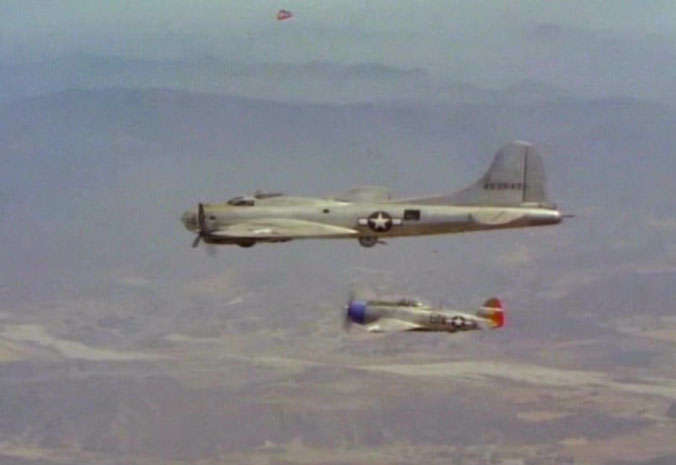
The second was Command Decision, filmed between April and July 1948. Here is a still from the film that airplane.
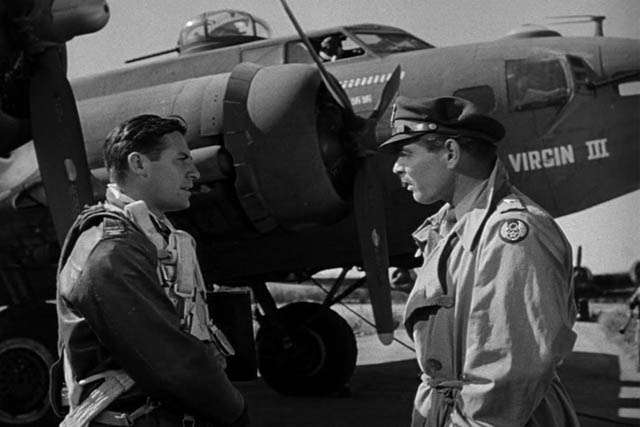
If so, it had temporary camouflage applied. Some details match: the astrodome and VHF antenna on top, plus the exhaust covers on the nacelles; however, the chin turret is missing, a lot of trouble but possible, so the jury is out on this one.
Within just a few short weeks since this airplane appeared in one or two films, it was evidently sold by Babb. There is no direct confirmation in any records available, but circumstantial evidence suggests it was, indeed, 44-83842 August 2012 update: nope...nope nope....that was the subject aircraft. According to Alex Yofe's book, it was purchased by Al Schwimmer in Akron, Ohio, and he and Leo Gardner flew it directly to Westchester, New York, where pilot "Swifty" Schindler joined the crew. My own records show a newspaper reports that this B-17 arrived at Westchester at 6:00 a.m. on July 12, 1948, and left that afternoon at 3:45 p.m., with "ten close-mouthed men" on board, plus 3,500 gallons of fuel. Also aboard: large wooden crates with "Jewish inscriptions," suspected of carrying ammunition, and unpacked spare parts for planes. The media report indicates that the airplane was, at this early date, marked as NL7712M. As a matter of note, the FAA shows has no record of N7712M ever having been assigned to a B-17.
The airplane next appears at Dartmouth Field near Halifax, Nova Scotia, where it was impounded by Canadian authorities for being in Canada without permission. It is not clear if the airplane diverted to Halifax because of mechanical or weather problems (probably) or intended to land there. In any event, media reports the airplane was being flown by Irwin Schindler on behalf of a Panamanian company, Service Airways, which other sources indicate was set up by Schwimmer to export the airplanes to Israel. It was no secret that weapons were on their way to the mideast, so the Canadians insisted the B-17 could only leave if it returned directly to the U.S. The crew grudgingly agreed and, on July 16, took off and immediately turned eastward over the Atlantic, but returned twenty minutes later after three engine cowlings had blown off in flight.
The Canadians were quite upset at this point. They informed the crew that after the airplane was airworthy, they would allow a ferry flight under escort of the RCAF back to the U.S. The crew agreed, but took off in the middle of the night, probably on July 17, and headed eastward. It was next reported as landing at Santa Maria in the Azores for fuel. Before the crew could depart again, the U.S. requested that the airplane be impounded and the crew held, to which the Portuguese readily agreed. In the end, the airplane remained in the Azores and crew was eventually released to fly another day, probably in Israel. Here is a view of the airplane, reportedly on the ground at Santa Maria.
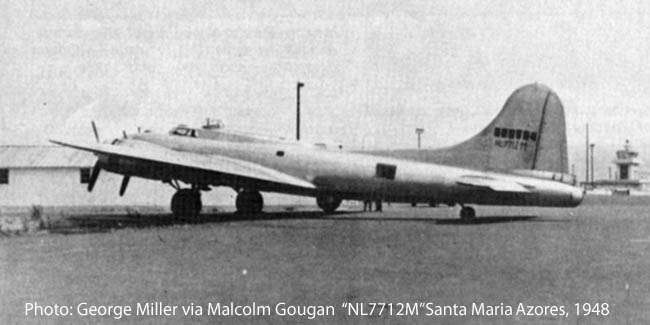
So, what then? Well, the airplane disappears. Two viable theories: A USAF Major, E.J. White, was stationed in the Azores at this time and reports that he had talked to the pilot and other crewmembers when it was on the ground at Santa Maria. (This is as per a letter from White published in the Spring 1985 issue of Warbirds International The pilot, presumably Schindler, told White that this was his third delivery trip, the first two being successful. Though the plane was impounded by the Portuguese, the pilot had somehow managed to have it serviced and fueled and ready to go if the circumstances allowed him to slip away. They did not, apparently.
White reports that ultimately the B-17 was assumed by the Portuguese Air Force, which was also operating several SB-17Gs at nearby Lajes Air Base. But, when it was flown to Lajes, it hit a Portugese guard vehicle upon landing and was totaled. This would be the only bit of credible information about the fate of the airplane and is probably correct.
However, an unknown and unidentifiPortuguese ed B-17G turned up in the Dominican Republic in mid September 1948 looking, at least in later photos, as if it could be a match for 44-83842. This is more circumstantial that anything else, but there is at least one old report that indicates the B-17G that showed up in the Dominican Republic in September 1948 was the impounded Israeli airplane. We may never know, but it remains a bit of a mystery.
- Tip of the Hat: Finally, the Collings Foundation brought its B-17G Nine O Nine, 44-83575 (N93012), to the Sacramento area during the first weekend of June. Did not get a chance to get over to McClellan Field to see it and the B-24 and the Me-262(!!), but on two occasions the B-17 took a turn over where I happened to be. The distinctive rumble of four Wright radials is hard to miss, and it announces its presence well before it comes into view overhead. The majestic nature of the airplane never dims, at least in my eyes, and here is a tip of the hat to the guys that keep the Collings airplanes out there, and to the larger group of volunteers and employees and owners and operators of this and the other several B-17s that still fly regularly and make a point of getting out there. Here's to blue skies and tailwinds (and cheaper avgas)...
May 2012 Addendum
- Memphis Belle Slated to Tour With Liberty Foundation? An announcement was made by Liberty Foundation chief pilot Ray Fowler that the MARC B-17G 44-83546 (N3703G) is going to be flown on tour by the foundation along with its P-40, presumably this summer. As announced on Warbird Radio on May 10:
WARBIRD RADIO – The B-17 used in the 1990 movie The Memphis Belle is set to tour the United States. According to Liberty Foundation Chief Pilot Ray Fowler, the movie Memphis Belle will soon be on tour with the Liberty Foundation’s P-40.
Whether or not rides will be offered while touring this summer may be a bit trickier question due to a required exemption to Federal Aviation Regulations that is applied by the FAA to the specific aircraft to be used. Time will tell.
As an aside, and alluded to below, there were also rumors flying that the Liberty Foundation will acquire the B-17E airframe 41-9032 and restore it to airworthy condition. No further word on that rumor...and it may just be idle speculation. I am quietly waiting next to my phone and next to my computer for someone who really knows to pass along some real information. Standing by....
- Continued Progress on City of Savannah: Pat Carry copies me on the monthly newsletter put out by the Mighty Eighth Air Force Museum at Pooler, Georgia, the group doing the static restoration on B-17G 44-83814. It has been mentioned on these pages before, but it should be mentioned again that, at least from afar, that is, from across the continent, the effort of this group is impressive and significant.
They have taken a neglected and forgotten airframe held by the National Air and Space Museum and are quite lovingly restoring it back to excellent display condition as a centerpiece of the museum display area. The latest newsletter speaks of the effort to set up a lubrication program for the engines, for a static airplane display yet? The airplane will also have a working electrical system for interior lighting and other systems, for the airplane will be opened up for special interior tours as part of the museum's educational mission. These guys are doing it right....kudos to the team at Savannah...er, Pooler. Might I suggest you check out the website and maybe even get your own subscription to the newsletter and not be lazy and make someone else send you a copy....
May 2012
- My Gal Sal May Have to Move: The city of Cincinnati, Ohio, has announced that the Blue Ash Airport will be closed effective June 8, 2012. Besides the sadness in seeing another airport close, it may effect a rare B-17E, 41-9032 aka My Gal Sal, that is held in storage at the airport. This airplane is owned by the Ultimate Sacrifice group and its leader, Bob Ready, has long planned a display facility for the airport to house the aircraft. Where those plans are now going to go is up in the air. This B-17E was recovered from the Greenland icecap by Gary Larkins many years ago, and was eventually rebuilt in part by him for the non-profit Ultimate Sacrifice group. Not that the airplane needs to necessarily move.
I will add that there are a few rumbles of rumors about the airframe changing hands and direction. I'll withhold further speculation as it is pretty pointless.
- Stored B-17s in post war Germany: Stephen Chapis sent in a photo that shows part of a field full of new B-17s in storage with the occupation forces in southern Germany near Munich in the immediate post war period.
This photo was sent from his grandfather to his grandmother in the mail. He was apparently attached to the 45th Air Depot Group at the time. The back of the photo is interesting but the location cannot be determined. The post war AAF had a half dozen airfields in the area after the war but the names don't match up.
If anyone can shed further light on this photo or its location, please let us know.
- Sleepy Time Gal Gets a Top: Jim Mandelblatt sent in a recent photo of the B-17G (nee DB-17P), 44-83624, aka Sleepy Time Gal, on display at the AMC Museum at Dover AFB with its new top turret shell. This airplane has long been displayed without the top turret and it was recently added to help complete the display aircraft. Just a shell at this point, but it looks nice, don't you think?
- Grissom B-17G and Warbird Rescue: Way back in March, Chris Henry passed along some information on the continuing slow work of improving the condition of the Grissom Museum B-17G (nee, DB-17P), 44-83690. The Warbird Rescue group worked out a deal that sent the Cheyenne tail compartment off the B-17 to the Mighty Eighth Air Force Museum for use as pattern for the B-17G, 44-83814 under rebuild there. It will come back to the Grissom airplane in rebuilt condition. Also in work are new, presumably, fiberglass cheek windows and gun mounts that will be added to up to four B-17Gs at some point in the future. The spare part cache of the Grissom group provided a B-17 forward hatch to the National World War II effort to place a static B-17G on display in the museum at New Orleans.
- 1970 Photo of B-17F: Nick Veronico passed along a couple of photos he recently obtained of B-17F 42-3374 shortly after it was moved from the MGM movie lot in Culver City to the Air Museum facility at the Ontario Airport (both in California).
This B-17F was a movie prop, though what films it actually appeared in remains a mystery. It was presumably given (or lent?) by the AAF to MGM during World War II for film use. Its last AAF notation was placement in 'Class 26', basically for disposal. It remained with MGM until 1970 when it was sold or auctioned or given away, with Ed Maloney obtaining the airframe pretty much intact. It bounced about with the Air Museum for a decade, and then was traded into the USAF Museum collection and was finally reassembled and displayed at the Beale AFB base museum for several years. It was finally sent to Offutt AFB in Nebraska where it remains as a gate guardian on (outdoor) duty.
- Chino B-17G Progress: Nick also sent in this photo of B-17G (nee DB-17P) 44-83684 taken at the Planes of Fame facility at Chino in February 2012.
This airframe remains under a slow restoration outside the museum facility. As can be seen here, the exterior is completely stripped of paint and the chin turret has been removed and replaced with a temporary skin patch. Work is slow and money is tight; kudos to the group working on the airplane for the progress made so far. As always, money is welcome so check out this website for more details.
- Chino B-17G In Earlier Days: Speaking of B-17G (nee DB-17P) 44-83684, Jim Zazas sent me a package of stuff from the P-51 Tournament airshow held at the East Alton (Illinois) airport in late May 1971. In the package were some photos of the Air Museum B-17G as a living, breathing, B-17 carrying the name Picadilly Lilly II.
This was apparently one of the last shows the B-17 attended before being grounded. It is probably best known for its starring role in the TV series 12 O'Clock High filmed at Chino in the early 1960s.
Okay, just one more photo from the airshow, though nothing to do with B-17s.
The just don't make airshows like they used to.
- Photos of Mary Ann Surface: Dik Shepherd sent in a pair of interesting photos he recently acquired of the B-17B that appeared as the Mary Ann in the 1943 film Air Force.
This B-17B (often mis-identified as a B-17C...not anymore thanks to several contributors here) has been identified (courtesy of some persistent Aero Vintage Forum users) as B-17B 38-584, but it was hoped that a blow up of the data block on one of these photos would provide the aboslute proof positive; however, those hopes were dashed as the digital data is not clear enough.
All indications, however (at least to me), suggest that this airplane is, in fact, 38-584. There is more elsewhere on this site about this discussion...search a bit and check out this dedicated page. In any event, these two photos are probably from a wartime promotion tour for the film. Interesting to see what shows up here and there.
- March Field Museum c. 1988: John Voss passed along one of his oldie photos from 1988 showing a time when there were two B-17s parked on display at the March Field Museum, the museum's 44-6393, then 2nd Patches, and the MARC B-17G 44-83546 (N3703G).
MARC's David Tallichet had a cozy relationship with the museum for a few years and one of his B-25s went to the museum for display. As part of that deal, he parked a few of his airworthy airplanes at March on display. Probably would not happen at any active USAF base today, eh?
John has a new website, by the way, and it is full of little goodies on an obscure subject: training field fuselage codes. A quick look draws you into a fascinating little research project. Most definitely, check it out.
January 2012
- Pink Lady in New Home: Ben Gilbert reports that French B-17G 44-8846, better known as The Pink Lady, has been moved into its new display hangar at Salis Aérodrome de Cerny in France.
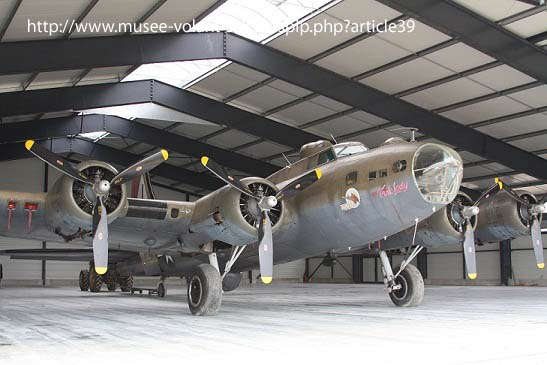
This airplane was grounded in 2010 by its owners but was promised, now fulfilled, at least a nice hangar for protection from the elements. This museum webpage has more details but you have to be able to read French. More photos, though. Thanks to Ben for the update.
- Movie Memphis Belle Photos and Lots of Them: Ben Gilbert also passed along a link to a UK Airshow Review forum page that has some excellent photos taken during the filming of The Memphis Belle way back in 1989 by 'comet14'.
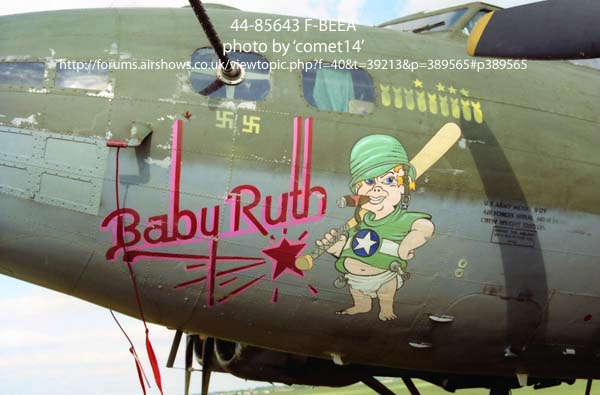
There is some good stuff, lots and lots of good stuff, here for any fans of this film, including both bombers and fighters. Good stuff. Lots of it.
- The Real Memphis Belle Progress: Continued and substantial progress is being made on the restoration of B-17F 41-24485, better known as the Memphis Belle, by the team at the National Museum of the USAF at Dayton, Ohio, as reported by Chris Henry (via WIX). The wings were reattached earlier this year, and now all four engines have been mounted on the nacelles.
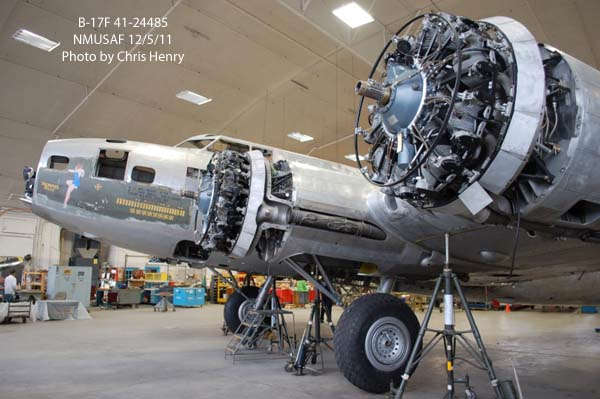
As has been noted in other updates through the years, this combat veteran of the 91st Bomb Group has undergone a complete rebuild from top to bottom. It was held by the city of Memphis for five decades and went through alternating periods of love and abuse until reclaimed by the NMUSAF for permanent display at one of the world's premier air museums.
One can only admire the loving attention to detail and "getting it right" effort being made to finally and completely restore this significant aviation treasure for generations to come.
- New Memphis Belle Memorial in Memphis: Speaking of the Memphis Belle, K. Kelly passed along news of the dedication of a new memorial for 41-24485 that was dedicated in Memphis in October 2011. The monument, unveiled at Overton Park’s Veterans Plaza before approximately 100 attendees, is a tribute to the popular and beloved airplane, its crew and support personnel. Through support from Boeing, FedEx and others, the Memphis Belle Memorial Association was able to erect and maintain the memorial. The monument is a life-size, bronze statue of Margaret Polk from the waist up. Polk was the sweetheart of Capt. Robert Morgan, who named the B-17 Flying Fortress the Memphis Belle in honor of her.
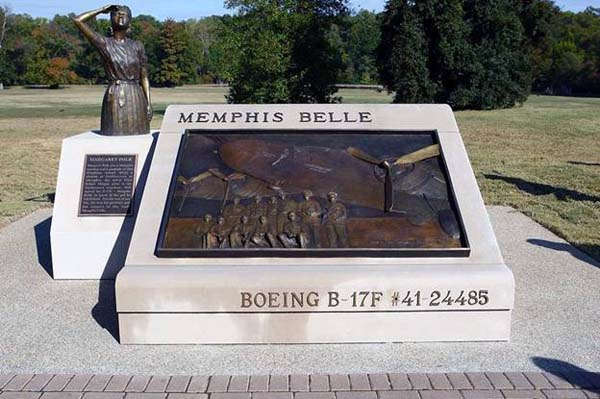
- Continue Progress on City of Savannah: The Mighty 8th Air Force Museum at Pooler, Georgia, continues forward on its static restoration project of the ex survey, ex air tanker, ex NASM B-17G 44-83814 that is already the centerpiece of the museum even though it is not yet done. These guys started with the shell of a corroded and neglected airframe and have slowly brought it back to an excellent representation of a combat worthy B-17G.
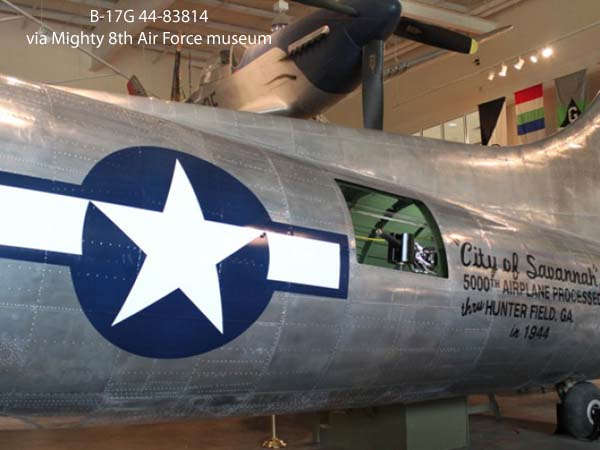
It is marked as City of Savannah and, though the major restoration of the airframe is completed, the task of locating and reinstalling all of the bits and pieces to complete the effort remains underway. For the curious of heart, I'd recommend some time perusing the website and the newsletter updates available on the museum website.
- 16.5 Tons of B-17 and Other Warbird Parts Dug Up: Neil Stevens provided some follow up information and photos of a multi-year effort to recover material from one of the 8th Air Force salvage dumps, this one located at Weybread in Norfolk. This effort was the culmination of years of research by several groups and individuals and, after all was said and done, over 16.5 metric tons of aircraft parts were recovered. That's actually quite a bit of material.
I don't think this effort was well covered on this side of the Atlantic but an amazing variety of different parts were recovered, from turret rings and oxygen bottles to discarded aircraft skin panels (with battle damage) to obscure little bits of aircraft flotsam.
Now, this will get a bit long but I think the background of this dig is quite interesting, and Neil Stevens provided an account written by his brother, Clive, of some of the details, which I provide here:
Weybread Pits, Harleston, Norfolk, East Anglia
In recent years, aviation enthusiasts and historians have been undertaking excavations at the site of a former dumping ground in England. Located in the Waveney Valley and within a 12 mile radius of countless American Eighth Air Force heavy bomber WWII airfields, the Weybread gravel pits were extensively excavated during wartime England to provide building materials for the construction of many of the local airfields in East Anglia. Naturally, this excavation would have left many large holes in the ground and it therefore seemed logical to use these holes for dumping surplus waste materials, rather than to dig new ones.
The location of this site was firstly established to the historians by former Harleston resident, Peter Snowling, who as a young boy growing up in the late 1940's, played in the surrounding fields, river and streams. One of his strongest recollections of the site was of countless heavy bomber Oxygen Bottles and long range P-51 Mustang Fighter external fuel (Drop) tanks, littering the site for many years after the war. This memory is so vivid because as youngsters, the children would string these buoyant items together to make rafts to float down the nearby River Waveney. Some children also used the Drop tanks as makeshift canoe's, but sadly this practice was brought to a swift conclusion when one of the children from the town drown from such activities.
So with the location of the field in question positively identified, local USAAF enthusiast Simon Dunham and his colleague Malcolm Weald, used geo-fizz equipment, fisher metal detectors and aerial photographs of the site taken in 1947 to pin-point the areas of the field which gave the strongest readings for both soil disturbance and metal readings. Enlisting the help of some 30 like-minded individuals to assist in funding the extensive operations (including myself), the first dig was undertaken in October 2009. After a half day digging up little more than brick rubble, hopes were starting to fad of actually finding anything with a firm USAAF pedigree, but after digging down some 4 meters to the water table, we started to strike gold! The resulting findings were to say the least, totally overwhelming, in both overall condition and sheer quantity.
Having returned to the site now on three major excavations from October 2009 - October 2011, we are satisified that we have now removed the vast amount of metal from the Weybread Site. If I were to briefly document the highlights in terms of finds, of course the sheer number of Oxygen bottles in all shapes and sizes ranging from the small green bail-out bottles right up to the large yellow bottles that you see aboard a B-17 or B-24 have certainly been impressive to see come out of the ground. The enormous pile of manifold collector ring sections from both B-24, B-17, P-38, C-47, P-47 and P-51 have also been a sight to behold - some of which have been so pristine that after grit-blasting, they would be suitable to fit back onto operational warbirds today. A number of the legendary shaped B-17 and B-24 Control Wheels have come out in varying conditions, some of which have been exceptionally tidy and if only they could tell their own individual stories of the pilots that have held them and the journeys they have made into occupied Europe. Two or three (I forget) P-47 and B-17 superchargers were unearthed complete and intact, which really made the digger grunt. But bringing the history of what we were undertaking very much to life, was the countless removable B-17 engine nacelle panels, which wrap around each engine nacelle and are routinely removed for inspection and engine maintenance, but more importantly, many of which bearing the serial number of the aircraft from which they had come. After cross-referencing many of these numbers, it was determined that we had aircraft panels from B-17's belonging the 91st, 95th, 96th, 100th, 385th, 388th, 490th, 493rd USAAF Heavy Bomb Groups, including such well known aircraft as the 91st Bomb Groups 'Happy Valley Express,' with its nose art painted by the legendary Tony Starcer (who also painted Memphis Belle) and the 100th BG aircraft 'Silver Dollar' which was removed from combat status and became the personal run-around of the 100th Bomb Group CO. Their were also countless other finds of a more obscure nature such as a hoard of empty earthenware Ginger Beer and glass beer bottles, from local breweries in Norwich, Ipswich and Stowmarket.
Why or how all this USAAF material found its way into the ground is still a little bit uncertain. It is believed that the site could well have been a communal dump for use by the local people, but it is also speculated that it could have been manned by RAF or British Servicemen for the use by the military. Local people recall that 6x6 trucks from the local USAAF base at Thorpe Abbotts with kindly drivers would often stop on the hill before entering the site to allow the local people to rummage through the materials being thrown out before being dumped. It was well known that the American GI's were often wasteful in comparison to their British cousins and would throw out all manner of left over's which the British citizens under ration conditions, were only too pleased to accept. 99% of the materials recovered however have been made of stainless steel, including all of the oxygen bottles, exhaust manifolds and nacelle panels. It is though that these items would have come from the large aircraft salvage facility at nearby Pulham St Mary, Norfolk. Here, damaged and salvaged heavy bombers of all varieties were cut-up and removed from site for melting down and it is speculated that the reprocessing of Stainless Steel was in its very early stages of development and therefore was of no scrap/salvage value - Thus, many of the items manufactured from this materials was classed as surplus and of no use, so what better way of disposing it that to fill large existing holes in the ground, soon to be covered over and forgotten about for over 65 years.
This photo shows what the recovery team was dealing with in digging up the material.
And one of the piles of what appear to be exhaust parts, mostly B-17 I would suspect.
A turbocharger assembly, most likely also from a B-17. That will buff right out.
Actually, these exhaust parts were later cleaned up and they appear, from the outside, to be entirely usable.
Or how about this B-17 engine cowling panel after it was cleaned up and polished?
For the record, several of the parts that were excavated have been tied to specific aircraft. Here is a compilation sent by Neil: Radio Call Plate: 42-31031 RAF SN: SR388 Panels from 43-37824 (452nd BG), 43-38681 (100th BG), 42-32090 (100th BG) Silver Dollar with black paint on outside, 43-38815 (493th BG), 43-37811 (100th BG), 43-38056 (490th BG), 43-38453 (95th BG), 43-38083 (91st BG) Happy Valley Express, 43-37807 (452nd BG), 43-37995 (490th BG) Crashed Sutton Valence Kent, and 42-97302 (379th BG) Scotch N' Soda crashed Carleton Rode Norfolk.
The panel from the 100th Bomb Group's Silver Dollar, pictured here with photographer Clive Stevens, is slated for the 100th BG Museum at Thorpe Abbots for display.
I found more information about these digs at this Aces, Contrails, and Unsung Heroes forum site. And, I would be remiss if I did not mention Neil Steven's Yanks in the Kinnet Valley website which, though not directly B-17 related, is a good place to visit for information about some specific activity by U.S. airmen in the UK during the war.
- Eglin B-17G: Mark Sublette visited the USAF Armament Museum at Eglin AFB (Florida) on December 24th and took a close look at B-17G 44-83863. The ex PB-1W and ex air tanker that has been on display there since 1975 was recently repainted but is still slowly sliding downhill despite the recent attention. It is quite difficult to maintain aircraft on outdoor display and the proximity to the Gulf Coast in this case adds more challenges. Mark passes along the following:
I am down on the Gulf Coast of Florida for the holiday visiting my Dad and brother. I went up to the USAF Armament Museum this afternoon and looked over 44-83863. She is now wearing a generic camouflage scheme that is a tad too brown rather than olive drab, and has had its correct serial replaced with that of B-17F-90-BO, 42-30180. The 96th BG shield was repainted on the starboard nose. The aircraft is unnamed. Of the four turbosuperchargers which all spun freely when the aircraft arrived at Eglin AFB in 1975, only number two is now free to turn. The others seem to be frozen by the application of paint. Clearly the exposure to the Gulf Coast sea air is not helping the condition of the airframe.
I appreciate him passing along the current situation.
- Report on 1943 B-17F Crash in Idaho: David Trojan sent me a file copy of a report entitled THE CRASH OF B-17F SN: 42-29563, A CLEARWATER NATIONAL FOREST PASSPORT IN TIME/REGION 1 outlining a research project of this Hobbs, New Mexico, accident that occurred on December 3, 1943. The crew got lost in bad weather and the crew of ten successfully bailed out, with the airplane subsequently crashing in a remote area of Idaho. Here is a photo from the report showing what appears to be the insignia on the upper wing.
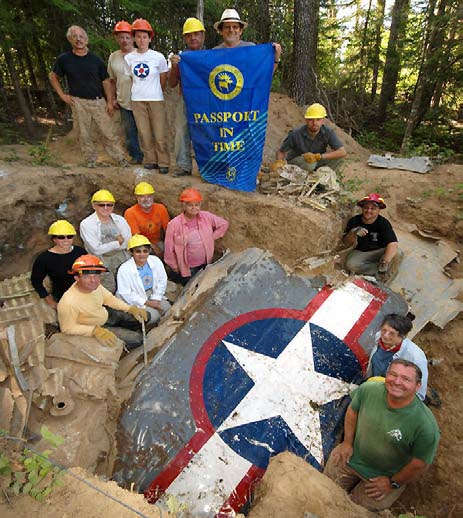
I was unable to find a link to the report online so I've uploaded it to my own server as a .pdf file that you can read right here. Among the things I found interesting was how the Army left the airplane wreckage..thus this excerpt:
This information suggested that a significant portion of the fuselage remained intact and was buried in that condition as part of the clean-up. The informant, a retired bulldozer operator for Potlatch Timber Corporation, was hired by the Army at the time to try to compact the largest intact sections of the airplane as much as possible. To a certain extent he was successful. However, he indicated that repeated attempts to drive his bulldozer over some portions of the fuselage were only partly accomplished and ultimately he was only able to fold the wings back and over the remains of the fuselage. According to his recollection, after folding the wings he then pushed the remaining mass just over the edge of the ridge and then buried the entire lot, pushing dirt over it rather than digging what would have been a very large excavation.
Those Army guys didn't mess around. - Seeking information on B-17G Ruby F: Tom Summers sent in this photo of an 97th BG B-17G named Ruby F for which he is trying to find out more information.
Tom's cousin, who is pictured front right, is now 93 years old and Tom asked if I had anything on this aircraft. My primary name and nose art source, Wallace Foreman's B-17 Nose Art Name Directory, unfortunately does not list this name so at this point I come up empty handed. Tom's cousin was a flight engineer with the 97th BG, 414 BS (15th Air Force). If anyone knows anything about this airplane please let me know and I will pass it back to Tom.
Tom has put contributed a lot of material to a very nice webpage, part of a larger and multi-faceted website, that is a tribute to his cousin, Doug Laurence, a gentleman who went on to long and interesting civilian career, including a bit of time with Elvis. Who?
- Lacey Lady Update: Dave Royal brought my attention back to B-17G 44-85790 that, for the most part, still languishes on a pylon over The Bomber complex in Milwaukie, Oregon. This airplane has been there since 1947 and is pretty bad condition. However, there is some behind the scene progress that should be mentioned.
First of all, an IRS qualified non-profit organization has been set up, the Wings of Freedom, so tax deductible donations can now be accepted. The board of directors is developing a plan to locate a building that will house the B-17 for an eventual restoration project, and they hope this will be near an airport as there is talk of this airplane being put back into airworthy condition.
Also, the restoration effort's website has been revamped and updated, so it is worth another visit if you haven't looked at it recently.
To go down memory lane, here is a photo of the airplane from days past:
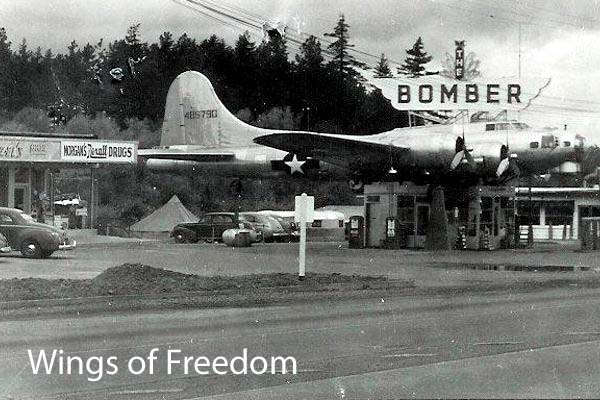
- Interior View of Tulare B-17: Michael Yamada came across some photos he took in 2003 of the DB-17P long parked at Tulare alongside California 99. These photos, one of which is here, show the gutted cockpit, barely recognizable as such. This airplane has been displayed since 1958 and has been stripped by vandals, souvenir hunters, and as the result of legitimate "salvaging" by restoration crews doing exterior work in exchange for parts. Not much left, as can bee seen.
Michael noted that he had arranged with the local AMVETS group that maintains the airplane to gain entry to the interior for these photos.
- Bozeman B-17F: Some new old photos have surfaced recently of another RFC B-17, this being B-17F 42-3470 that spent the years between 1945 and 1953 at Bozeman's Montana State College (now University). Both it and a P-51C (s/n 42-103645, now the CAF Red Tail) were obtained by the school for educational purposes. I've spent a bit of time at Bozeman over the years and have taken the opportunity to try and run down some information about these two airplanes, and managed to get most of the story. I wrote an account of the B-17F for FlyPast magazine a few years ago, using some of the material I had found in the university archives. Photos, however, were problematic and I ended up using some media excerpts for photos of the airplane while it was at Bozeman. I had also talked to Arlin Wass of Arlin's Aircraft Service at the Bozeman airport. Arlin is a bit of an old timer and he remember the airplane as he was a student at the school at the time, so he was able to add some details but, alas, no photos.
So, imagine my surprise when we stopped at Arlin's recently for overnight parking with one Lear 60. There on the wall, along with some other Bozeman airport vintage photos, was this photo:
It was printed in a large format and, as can be seen, provides a nice view of both airplanes. I spoke with Craig Hocevar from Arlin's and he was kind enough to send me copies of what had he in his files on these two very interesting airplanes.
One item that is notable and yet to be solved is the "M 95" marking on the aft fuselage and vertical stabilzier, suspected of being a training base marking but the base has not been identified or even if this is what the marking is for. Also, for the first time, is seen evidence of a name painted on the nose, and because this photo was taken before the airplane went to the school, it may have been present on the airplane when it arrived. Howver, nothing much more can be discerned of the name from the photo,
Among those items was this copy of a newspaper clipping that tells the story of the B-17F leaving on December 14, 1953, under the command of Owen S. Williams of California-Atlantic Airways, and heading for St. Petersburg, Florida. This clipping confirmed several details about this period of the airplane's history.
To add a short version of the rest of the story, the airplane went to Peru in August 1954 where it flew as OB-RAH-346, and eventually it went to Colombia. As noted in Aero Vintage July 2010 B-17 News, this airplane probably crashed in 1962 at Puerto Asis, Colombia, while operating as HK-580. A photo of it during that era:
Thanks much to Craig Hocevar and Arlin at Arlin's Aircraft Service.
- Old Photo Surfaces #1: Came across this interesting view of an unidentified Bolivian B-17E or B-17F (probably B-17E 41-9210) in service with a cargo carrier, possibly a beef hauler.
Bolivian companies utilized over two dozen B-17s in the post war years; drove them hard and most ended up crashing in the challenging environment of high density altitude, poor weather, and minimal maintenance.
- Old Photo Surfaces #2: And also coming to my files was this 1959-ish view of ex PB-1W 44-83864 operating with Mexican registration XB-BOE. Very freshly surplus in this view, retaining most the U.S. Navy paint and the top turret mounting ring.
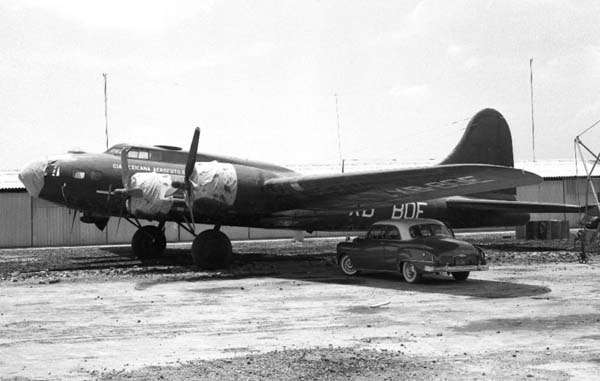
This airplane was used for photo survey work in Mexico before coming back to the U.S. for use as an airtanker. It crashed in New Mexico in July 1972.
B-17 News Archive
2018 B-17 News
2017 B-17 News
2016 B-17 News
2015 B-17 News
2014 B-17 News
2013 B-17 News
2012 B-17 News
2011 B-17 News
2010 B-17 News
2009 B-17 News
2008 B-17 News
2007 B-17 News
2006 B-17 News
2005 B-17 News
2004 B-17 News
2003 B-17 News
2002 B-17 News
1997-2001 B-17 News
Back to B-17 Information
Back to the Main Page
Updated: - Pink Lady in New Home: Ben Gilbert reports that French B-17G 44-8846, better known as The Pink Lady, has been moved into its new display hangar at Salis Aérodrome de Cerny in France.
Been too many months with too much going on, but it's time to add a few items of interest cruising through the B-17 world. Sorry to those folks who have sent stuff in to me only to have me sit on it...I will make an earnest attempt to clear out the backlogged file drawer. So, in no particular order...
- My Gal Sal May Have to Move: The city of Cincinnati, Ohio, has announced that the Blue Ash Airport will be closed effective June 8, 2012. Besides the sadness in seeing another airport close, it may effect a rare B-17E, 41-9032 aka My Gal Sal, that is held in storage at the airport. This airplane is owned by the Ultimate Sacrifice group and its leader, Bob Ready, has long planned a display facility for the airport to house the aircraft. Where those plans are now going to go is up in the air. This B-17E was recovered from the Greenland icecap by Gary Larkins many years ago, and was eventually rebuilt in part by him for the non-profit Ultimate Sacrifice group. Not that the airplane needs to necessarily move.
Two items that need to be added....
- Memphis Belle Slated to Tour With Liberty Foundation? An announcement was made by Liberty Foundation chief pilot Ray Fowler that the MARC B-17G 44-83546 (N3703G) is going to be flown on tour by the foundation along with its P-40, presumably this summer. As announced on Warbird Radio on May 10:
Some items that may be of some interest:
- Mock Memphis Belle On Tour: As noted last month, the Liberty Foundation has proceeded with putting the leased MARC B-17G, 44-83546 (N3703G) on a summer tour. A revamped website with tour dates and other information can be found right here. All four weekends in June have dates scheduled for areas in Georgia, Tennessee, and Ohio, starting at Peachtree-DeKalb Airport (Atlanta area) for June 9-10. The site promises that more dates will be added soon.
- Gas Station B-17 News: Interesting and long awaited news coming out of Milwaukie, Oregon, where B-17G 44-85790 has been displayed atop a gas station complex since 1947. Correspondent David Anderson reports that:
- My Gal Sal To New Orleans' National World War II Museum: In an surprise move, B-17E 41-9032, otherwise and better known as My Gal Sal has been donated by owner Bob Ready and the Ultimate Sacrifice group to the National World War II Museum at New Orleans, Louisiana. The airplane is being moved in early August, like right now, out of its long term storage warehouse at the Blue Ash Airport near Cincinnati, Ohio, shrink wrapped, and will be trucked to its new home. Surprising move because another B-17, B-17G 44-83387, had been under static restoration by a California group and slated for the New Orleans museum. Those plans have been shelved, and the B-17E will now be the one going on static display.
- My Gal Sal Update: Carey Mavor sent in some recent photos, taken in early September, of B-17E 41-9032 in short term storage at the National World War II Museum. As noted in the August update below, the airplane was acquired in a surprise move from Bob Ready and the Ultimate Sacrifice group, and quickly trucked from Ohio to the New Orleans facility. It is being prepared for hanging display in the museum.
